A brief history of Singapore’s North Region
In the years around and after Singapore’s independence, the North region of Singapore – comprised of Sembawang, Woodlands, and Yishun remained largely undeveloped. These areas served as kampungs, rubber plantations, and in the case of Sembawang, home to a naval base – both under British and Singaporean power.
Development in the north started with Yishun New Town in the 1980’s, followed by Woodlands later in the decade. Woodlands then rapidly took shape, growing into the regional centre. It featured the town’s transformation into the North’s largest residential town, featuring residential, industrial, and commercial developments.
The 90’s saw a decade of further change for the North, with the opening of Woodlands MRT as part of the North South Line expansion, and the subsequent opening of Woodlands checkpoint in 1999. This marked Woodlands as an important commercial and transport hub for Singaporeans and Malaysians alike, who would often transit through the regional centre to move between the two countries.

Sembawang Naval Base in the time of colonial rule
Interestingly, throughout these two decades, Sembawang remained relatively untouched as a naval base, until the turn of the millennium where we began to see a shift towards a residential town and estate through the construction of HDB flats.
Sembawang Today
Today, Sembawang has grown into a fully-fledged residential town. Its naval heritage remains, with road names in the town paying homage to the British naval vessels that once used to grace the docks of the northern town. A prominent example of this would be the planning subzone Canberra, named after the old HMS Canberra.
A visit to Sembawang today would present you with the picture of an idyllic suburban estate. The town is quiet and peaceful, particularly due to its lower density. Of all the residential towns in the North region, Sembawang is by far the smallest, housing just over 30,000 dwelling units.

Sembawang today is a quaint residential town, with around 30,000 homes
In comparison, Woodlands, the regional centre of the North is home to almost 72,000 dwelling units, while Yishun, the other large residential town in the north is also home to over 69,000 of such homes.
With less than half as many homes, it is evident that Sembawang has received less love than its neighbours. But with a projected ultimate capacity of 65,000 – over double of the current inventory in the area, it is clear that Sembawang will be the next town to experience rapid development.
Bukit Canberra
Spearheading Sembawang’s development and transformation into a new-age residential town is Bukit Canberra, an integrated community and sports hub.
Partially opened since 2021, Bukit Canberra is modelled after Our Tampines Hub, aiming to integrate community focused amenities such as healthcare and dining with sports facilities to promote a greener and more active lifestyle among Singaporeans.
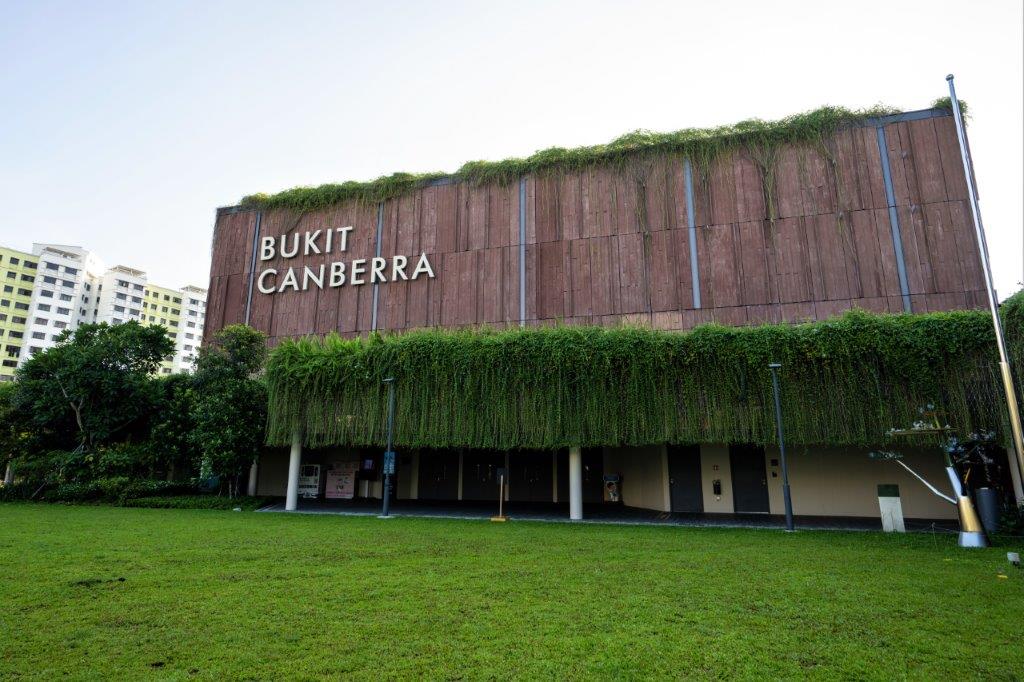
The facility comprises extensive sports facilities, such as indoor and outdoor lap pools, 3km of running trails, a polyclinic, a senior care centre, and a hawker centre with 800 seats and over 40 stalls.
Despite being an entirely modern and new development, Bukit Canberra also does its best to preserve Sembawang’s roots. It is built on the site of the old Chong Pang Village market and hawker centre and will house the refurbished Admiralty House into a library full of historic stories of Sembawang’s naval past during colonial times.
Other Amenities
Shopping and Retail
Despite its small size, Sembawang is home to two shopping centres, Sun Plaza (located next to Sembawang MRT) and Canberra Plaza, an integrated development next to Canberra MRT.
Across the two malls spanning both the neighbourhood’s MRT stations, residents have easy access to amenities and services such as grocery stores, dining options, clinics, enrichment centres, and retail shops. These options easily provide day-to-day necessities for its residents, while alternatives can be easily accessed within 5 minutes at either Yishun or Woodlands, which boast large shopping malls of their own.

Sun Plaza, one of the malls that serve the residents of Sembawang
Nature and Recreation
In terms of recreation, Sembawang is home to its very own Sembawang Park, which is a seaside park with beaches, barbecue pits, and views of the Johor Strait.
Sembawang is also unique as it is home to Sembawang Hot Spring Park, the only natural hot spring park in Singapore. Visitors can enjoy foot-soaking pools and heritage exhibits in a well-maintained and landscaped setting.
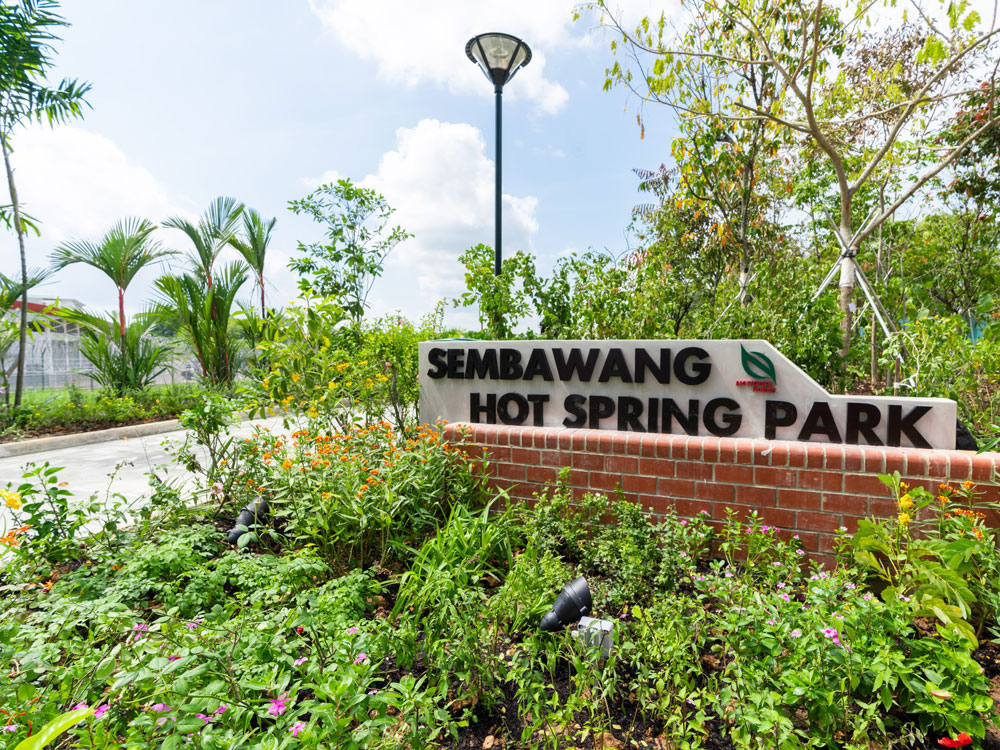
Sembawang Hot Spring park is home to the only natural hot spring in Singapore
Transport and Accessibility
Sembawang is connected to Singapore’s transport network through two stations on the North-South Line, Sembawang and Canberra. The line connects Sembawang directly to the city centre in around 30-minutes.
The most recent Thomson-East Coast Line runs through Woodlands MRT station, a mere two stop from Sembawang. The additional line provides access to additional locations, such as various parts of Woodlands, and even all the way through to the east coast of Singapore.
In addition to this, various feeder buses serve the town, providing easier access to nearby MRT stations for residents that might stay slightly out of walking distance from the MRT.
North-South Corridor
Sembawang will also directly benefit from the future North-South Corridor (NSC). The 21.5km multi-vehicle expressway will directly connect Woodlands to Marina Bay and promises a much faster commute to the city for residents in the North region.
The NSC will cut travel times by 10-15 minutes during peak hours, and reduce the reliance on the often-congested Central Expressway. There will also be express bus services to serve those that do not own a vehicle, allowing them a much faster commute on public transport to the city centre.
A New Neighbourhood in Sembawang North
You might ask: what’s the purpose of constructing so many amenities for a town with such a low number of residents? With many plans for development in Sembawang, the picture starts to become clear.
Announced by the Ministry of Development and Housing Development Board in October 2024, we can expect around 8,000 BTO flats and 2,000 new private housing units to be constructed in Sembawang North, a planned 53-hectare residential neighbourhood.
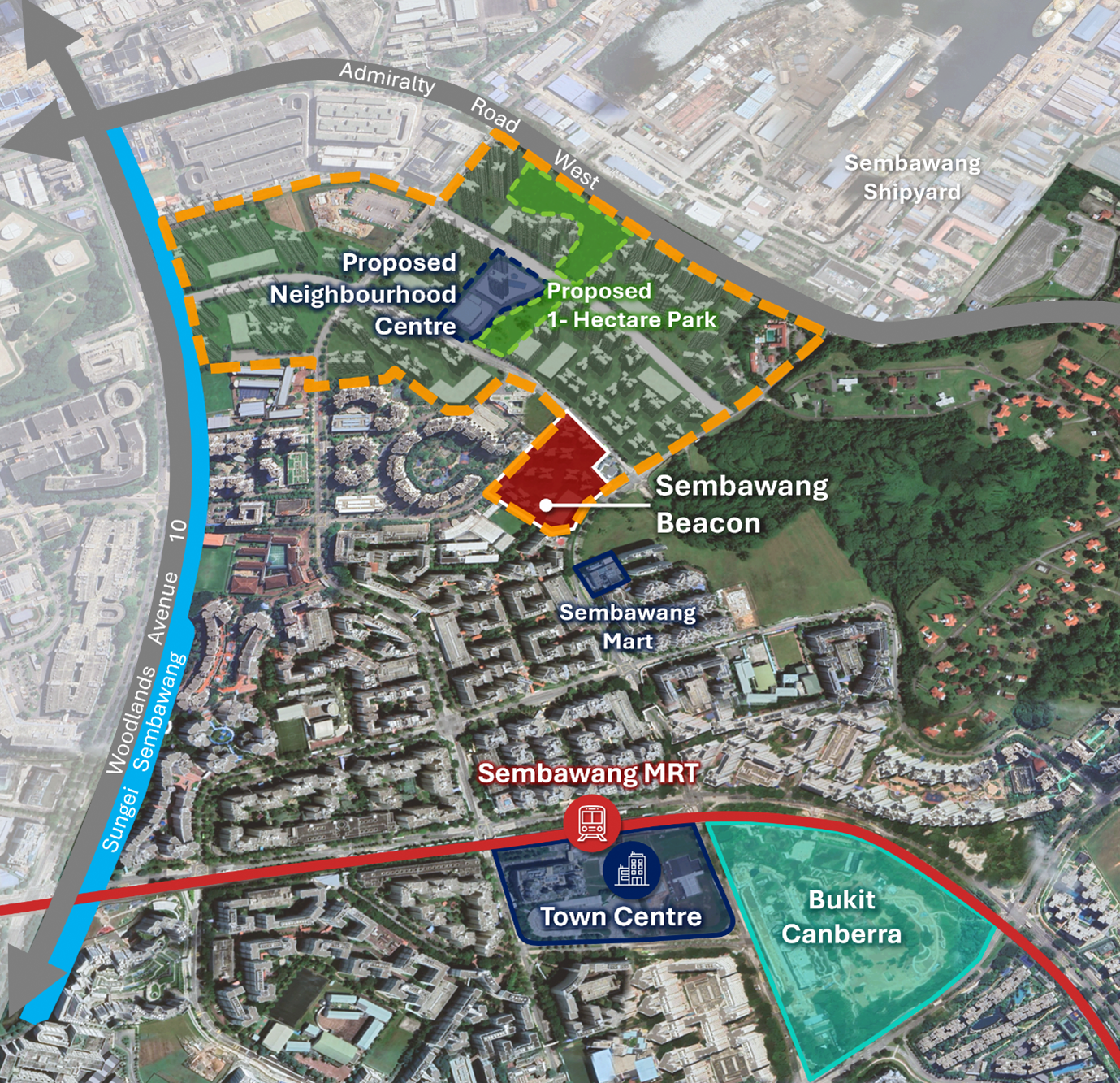
This starts with the BTO exercise in July 2025, where a 775-unit development, Sembawang Beacon will be the first of many housing projects that will occupy the up-and-coming neighbourhood. Additionally, the project completion timeline is slated to be under three years, as it is classified as a Shorter Waiting Time (SWT) project.
SWT projects are normally selected in up-and-coming locations with ample development potential, shoring up confidence that Sembawang North’s development is a priority.
What about the Private Market?
Sembawang is also receiving further development interests in the private and executive condominium markets as well. Currently, there are a few non-landed private homes in the town. As the town still has much room to grow, we can expect many more new condominiums and even ECs built here in the future.
In July 2024, a private residential land parcel was sold via the Government Land Sales at Canberra Crescent.
Chart 1: Land Cost for OCR Private Non-Landed Developments
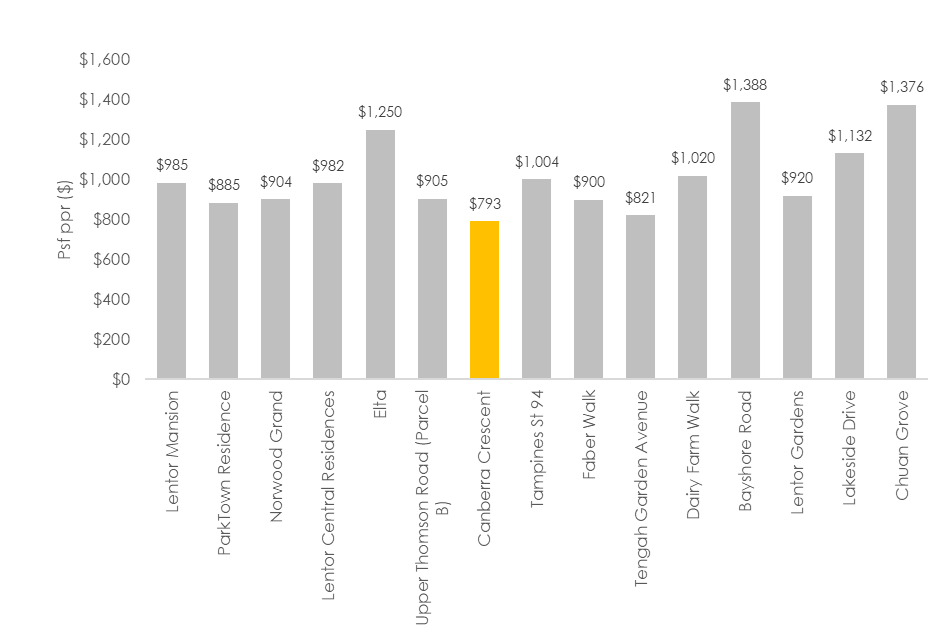
Source: URA, ERA Research and Market Intelligence as at 21 July 2025
Furthermore, the GLS plot at Canberra Crescent was also tendered at a more attractive land rate compared to other Outside Central Region (OCR) sites. With a land rate of $793 psf ppr, Canberra Crescent Residences, slated to launch in Aug 2025 should feature attractive pricing, allowing buyers to buy into the estate at an accessible price point.
The last new condominiums in the area were The Watergardens at Canberra and The Commondore, both which were launched in 2021. Since then, we have witnessed resale transactions averaging $1,755 psf at The Watergardens at Canberra. This resale price, a significant increase from the median price of $1,469 psf witnessed during its launch month highlights the area’s growth and potential.
Chart 2: Canberra Crescent GLS and EC price comparison

Source: HDB, URA, ERA Research and Market Intelligence
With a land rate that is comparable with that of the last 3 EC sites tendered, Canberra Crescent Residences should offer a compelling alternative for a private property upgrade to HDB owners in the surrounding estate that might have originally been considering an EC instead.
Executive Condominiums (EC)
Recently, in May 2025 we also saw the opening of a GLS tender for an EC site at Sembawang Road. This is the first EC introduced in Sembawang since 2021. The introduction of ECs is a great way to support the development of the town and provides a sustainable upgrading and housing option.
There is currently no stock for ECs, with North Gaia, the last EC launched in the North region having sold out the remainder of its units earlier this year. While there is certainly a supply gap in the market for North region ECs, the demand for this Sembawang site might be moderated by another EC parcel that is currently on sale at Woodlands.
Conclusion
From the full completion of Bukit Canberra, to the upcoming BTO, EC, and private home launches, there is much to be excited about for the quaint town of Sembawang.
The prospect of staying in the North is getting better as time goes by, with developmental plans for not only Sembawang, but in Yishun (the new precinct Chencharu), and Woodlands (Woodlands North Coast and Woodlands regional centre).
With much to look out for – now might very well be the right time to consider investing or staying in Sembawang. If you are curious on how you can do so, do not hesitate to speak to an ERA Trusted Adviser today.
Disclaimer
This information is provided solely on a goodwill basis and does not relieve parties of their responsibility to verify the information from the relevant sources and/or seek appropriate advice from relevant professionals such as valuers, financial advisers, bankers and lawyers. For avoidance of doubt, ERA Realty Network and its salesperson accepts no responsibility for the accuracy, reliability and/or completeness of the information provided. Copyright in this publication is owned by ERA and this publication may not be reproduced or transmitted in any form or by any means, in whole or in part, without prior written approval.
Punggol was developed over the two decades and is emerging as a choice location for many homeowners. In the next decade or so, we can almost visualise how Tengah will be evolving and mirroring the growth of the Punggol estate.
In 1996, the blueprint for Punggol 21 was unveiled to develop Punggol as a Waterfront Town of the 21st century. Today, it is a vibrant residential town home to an HDB resident population of 187,800, as well as the Punggol Digital District and the Singapore Institute of Technology. Tengah may undergo a similar transformation.
Both towns were developed off greenfield sites. Homes were built to support commercial and industrial hubs – Punggol Digital District and Jurong Innovation District for Punggol and Tengah respectively. Additionally, universities were located near these towns to foster stronger industrial-academia collaborations between these nodes. Furthermore, both towns have reliable public transport nodes within their towns, with the Punggol LRT and the Jurong Region Line serving residents.
One difference is that Punggol is located in the North-East Region, while Tengah is in the West Region. Following the announcement of the development of Tengah, could we potentially see Tengah mirroring the growth of Punggol?
This piece will talk about what Tengah currently offers and future plans for this new forest town.
Tengah – the 24th and latest HDB town
Tengah is located within the West Region of Singapore. It is bordered by Bukit Batok to the east, Chua Chu Kang and Bukit Panjang to the north-east, Western Water Catchment to the north and west, and Jurong East and Jurong West to the south.
Image 1: Developed New Township of Tengah

Source: ERA Research and Market Intelligence
HDB first announced the development of Tengah town in 2016. Billed as a “forest town”, the estate will span nearly 700 hectares. It is similar to the size of Bishan and will house nearly 42,000 new homes when fully developed. Homes in Tengah will be located across five districts, each with their own unique character.
What sets Tengah apart is that it will be the first sustainable housing town in Singapore. The estate is set to boost smart technologies and eco-friendly features, driving Singapore’s commitment to meet our sustainability targets.
The Tengah town centre, which will be known as The Market Place, will be within the Park District. It will be Singapore’s first “car-free” Town Centre where the roads will run beneath the Town Centre, freeing up space at the ground level for shopping and recreational uses. As such, walking and cycling are the encouraged modes of transport within the estate. Tengah MRT Station on the future Jurong Region Line (JRL) will be located there. Other features include the Central Park, Rainforest Walk and a plethora of retail and dining services.
Image 2: Map of Districts in Tengah

Source: Google Maps, ERA Research and Market Intelligence
Amenities and Connectivity
The completion of the first 10,000 HDB flats in Tengah in 2023 marked a major milestone for the new town, drawing in its first wave of residents. However, early hurdles quickly emerged with residents facing a lack of amenities and transport options.
Since then, Tengah’s first Neighbourhood Centre, Plantation Plaza, has been completed. Located within Plantation District, which will have 10,000 new homes when fully completed, it will serve the daily needs of residents. It houses a wide variety of dining, retail, healthcare and recreational services.
Image 3: Plantation Plaza Shopping Mall in Tengah

Source: HDB
As the residential population in Tengah is still relatively small, there are currently only a few schools in the area. However, it was announced by the MOE that new schools will be set up in newer estates such as Tengah and Punggol. Schools within Tengah includes Pioneer Primary School, Anglo-Chinese School (Primary), and Bukit View Primary School.
With Tengah planned as a car-lite town, more transport nodes have been planned in comparison to other towns. There will be four MRT stations on the upcoming Jurong Region Line (JRL). These stations are slated to start operations in phases between 2027 and 2028. Additionally, the Brickland District will be served by Brickland MRT Station (NS3A) on the North South line. The station is aimed to be completed by 2034.
In terms of bus connectivity, Tengah currently has a bus interchange with 5 services connecting commuters to parts of Jurong and Bukit Batok. By the end of 2025, it was announced that there would be two new bus services introduced, and six more by 2026. Most bus stops in Tengah will be within 300 metres of residential estates.
Image 4: Map of stations on Jurong Region Line serving Tengah

Source: HDB, ERA Research and Market Intelligence
With these MRT stations, residents would be three stations away from Jurong East MRT and Chua Chu Kang MRT, which serves the East West and North South Lines respectively, enhancing connectivity throughout the island.
Jurong Innovation District
The Jurong Innovation District (JID) is a 620-hectare industrial district is home to advanced manufacturing, supporting an ecosystem of manufacturers, technology providers, researchers and education institutions with Nanyang Technological University nearby. It is located around 14 minutes away from Tengah by car. When the Jurong Region Line is completed, connectivity between the places will be improved with the JID being served by Corporation Station (JS5) on the line. It will be one stop away from Hong Kah MRT station.
Image 6: Artist Impression of the future Jurong Innovation District

Source: JTC, ERA Research and Market Intelligence
When completed, the JID is expected to introduce about 95,000 new jobs in advanced manufacturing, innovation and research. Individuals working in this district or industry could look at housing in Tengah, as it is a short distance away from JID, as well as the Jurong Lake District, which contributes 100,000 more jobs. Furthermore, housing in Tengah is likely to be affordable to attract more Singaporeans to the new town.
According to the URA Master Plan, Tengah has several plots of land zoned for commercial use, including a recent GLS site which is zoned for commercial and residential use. This could further boost the number of jobs available within this district.
What’s next for Tengah
Currently, there are no new private condominium developments in Tengah planning area. As of June 2025, there have been four EC launches and 22,521 HDB units launched across 20 BTO estates in Tengah. Six BTO estates are yet to be completed with the latest slated to be completed by 2Q 2027.
Table 2: Details of Projects in and around Tengah

Source: URA as of 1 July 2025, ERA Research and Market Intelligence
The first private condominium GLS site was awarded in January 2025 along Tengah Garden Avenue. The site was tendered at $821 per square foot per plot ratio (psf ppr) and can yield around 800 units. It is located conveniently next to the future Hong Kah MRT station. It is expected to launch in 2026 and be completed by 2030.
In Closing
Tengah reflects many similarities to the early days of Punggol. They were both developed from the ground up, supported by strong intra-connectivity, and developed near innovation hubs. However, Tengah has some elements of uniqueness, having a strong focus on sustainability, smart living, as well as being home to Singapore’s first car free town centre.
One key difference between both towns – Tengah’s flats have a height restriction due to its proximity to Tengah Air Base. While Tengah may not replicate Punggol’s scale or waterfront appeal, it is positioned to achieve similar or greater success in terms of liveability, sustainability, and job opportunities. With a strong emphasis on sustainability in its planning, as well as being strategically located to the future Jurong Innovation Hub which will provide jobs, it has a strong foundation set for long term growth.
Are you interested to live in an up-and-coming estate that will see major transformations in the years to come? If so, Tengah is a place that you can call home. There is another upcoming EC launch in 2025. Interested to know more? Speak to any ERA Trusted Advisor today to find out more!
Disclaimer
This information is provided solely on a goodwill basis and does not relieve parties of their responsibility to verify the information from the relevant sources and/or seek appropriate advice from relevant professionals such as valuers, financial advisers, bankers and lawyers. For avoidance of doubt, ERA Realty Network and its salesperson accepts no responsibility for the accuracy, reliability and/or completeness of the information provided. Copyright in this publication is owned by ERA and this publication may not be reproduced or transmitted in any form or by any means, in whole or in part, without prior written approval.
Co-written By Egan Mah & Stanley Lim
It’s the classic narrative of Singapore’s housing landscape: dating, getting married, and then moving into a newly completed Build-to-Order (BTO) flat as newlyweds. However, this familiar route isn’t always accessible to everyone, whether by personal choice or due to circumstances beyond their control.
Thankfully, for those who are unable to enjoy shared ownership of a property with a spouse, there are still avenues to enter Singapore’s property market with a trusted someone – be they a live-in partner, close friend, or family member. This guide will explore the various housing options, eligibility criteria, and key considerations for co-owning a Singapore property even when legal marriage isn’t on the cards.
Why is property co-ownership outside of marriage a consideration for some Singaporeans?
There are numerous reasons why some Singaporeans might opt to co-own a residential property outside of marriage.
While some aspiring homeowners may choose to do so due to practical concerns, such as financial constraints or caregiving responsibilities towards a disabled and/or elderly family member, others may be motivated by personal circumstances. Moreover, not all aspiring homeowners fall within the conventional definitions of family or marital status; yet they too are also seeking pathways to co-ownership.
For instance, a widower who has found love again may choose not to remarry to avoid the hurdles of legal marriage. Accordingly, they might choose to co-own a property with their new partner, which would enable them to build a shared home, sans the bureaucracy and formalities.
From a purely financial perspective, there is also a compelling case for co-ownership outside of marriage, given the robustness of Singapore’s property market. Property has long been regarded as a reliable investment asset locally, owing to its history of consistent appreciation. Between 2021 and 2025 alone, HDB flats and private homes have experienced significant upward momentum, as evidenced by the sharp 41.3% (142.2 to 200.9) and 30.1% (162.2 to 211.1) increases in their respective price indices.
Chart 1: HDB resale price index (RPI) and private residential property price index (PPI) from 1Q 2021 to 1Q 2025

Source: URA, HDB, ERA Research and Market Intelligence
In this light, property co-ownership transcends merely fulfilling housing needs; it also represents a strategic decision for long-term financial security. This is especially relevant for those who may not have children of their own and/or lack familial support in later stages of life.
However, given the increasing proportion of singles in Singapore’s resident population, personal choice and/or a desire for freedom are likely the main factors influencing interest in alternative paths to homeownership, including co-ownership arrangements.
Chart 2: Growth in single-person households as a proportion of total resident households (2000 – 2024)
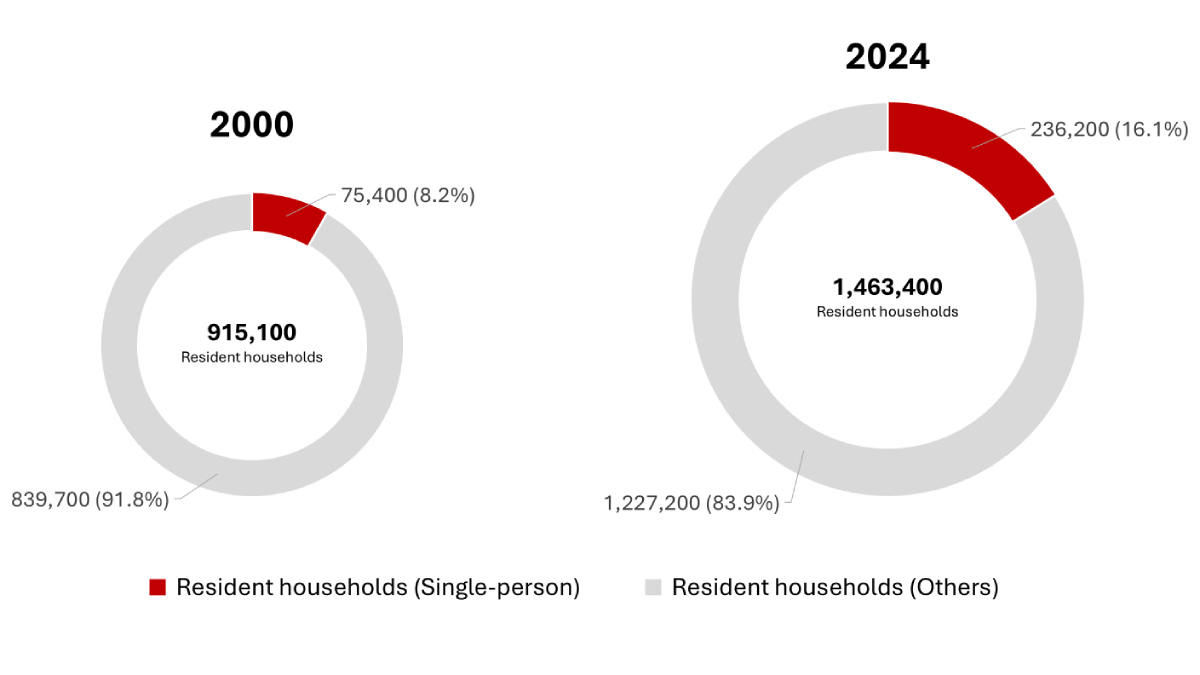
Source: SingStat, ERA Research and Market Intelligence
These beliefs tie in with a greater preference for single living as well, especially among Singaporeans seeking flexibility and privacy. Based on official SingStat figures, the number of single-person resident households has risen by over 200% from 75,400 in 2020 to 236,200 in 2024. Likewise, the share of single-person resident households has also seen a notable increase, doubling from 8.2% in 2000 (75,400 of 915,100 households) to 16.1% in 2024 (236,200 of 1,463,400 households).
Therefore, given the increasing prevalence of singlehood among Singaporeans, it is reasonable to suggest that there may indeed be a growing need to reimagine local homeownership beyond the traditional couple-centric model.
The Singapore Government has taken steps in this direction, with the most recent change being the expansion of public housing options for singles. A key policy revision in the second half of 2024 now allows singles – or, for co-ownership purposes, groups of up to four singles – to purchase 2-room Flexi HDB flats in any housing estate, including prime locations.
However, different homeownership requirements and considerations will apply depending on whether one is considering co-owning an HDB flat, an executive condominium (EC), or private housing.

What are the laws, rules and considerations for co-owning different residential properties for joint-singles?
Buying an HDB flat will require all parties to be at least 35 years old.
While HDB offers numerous eligibility schemes to support various demographic groups in their housing journey, single buyers interested in co-owning a flat need only focus on one: the Joint Singles Scheme.
Introduced in 1990, the Joint Singles Scheme allows eligible Singaporean men and women at least 35 years old to jointly purchase an HDB flat or Executive Condominium (EC). However, those who are widowed or orphaned may qualify from the age of 21, but only for resale Prime flats, unclassified resale flats, and new Standard and Plus flats.
For the purposes of this piece, we consider joint single households to be living arrangements involving two to four unmarried individuals of any gender. Additionally, if you intend to apply under the Joint Singles Scheme, it is important to take note of the following requirements:
Table 1: Joint singles eligibility criteria for HDB and EC flat purchases

Source: HDB, ERA Research and Market Intelligence
*Unclassified resale flats refer to HDB homes sold before the October 2024 sales exercise that do not fall under either Standard, Plus, or Prime classification categories.
Private home ownership is less cumbersome.
Unlike HDB flats or Executive Condominiums, purchasing private property as co-owners is not subject to specific eligibility criteria. However, co-buyers must consider the manner of holding or, more simply, how ownership is legally shared. This is particularly important for inheritance, as the selected holding method determines how the property is passed on after a co-owner’s death.
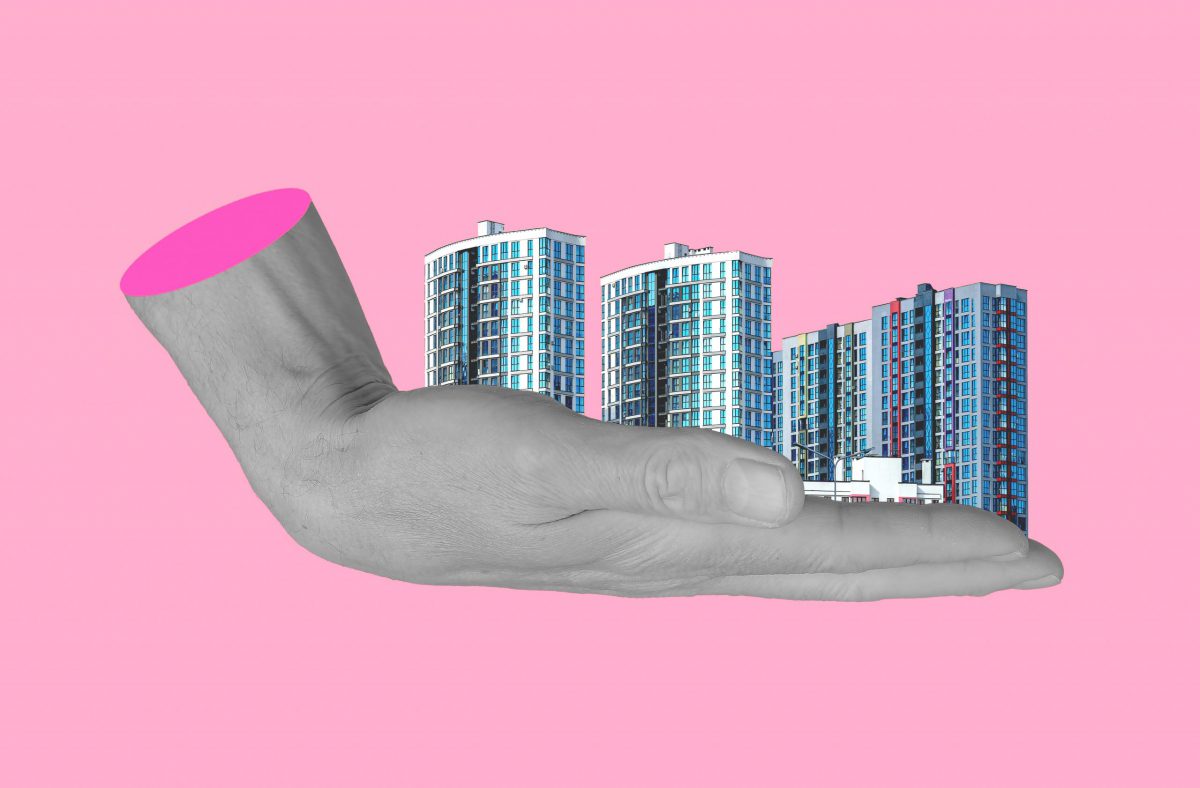
What are the different manners of holding or ownership types, and how do they matter in inheritance planning?
So, there are two property ownership types in Singapore, namely holding the property in Joint Tenancy and Tenancy-in-common. For HDBs, applicants under the Joint Singles Scheme must be registered as co-owners (i.e. the owner-occupier structure is not allowed).
While joint tenancy is the default holding method for HDB flats, buyers can opt for tenancy-in-common. However, this may come with higher legal fees due to the higher complexity of arrangements and the potential for disagreements.
- Joint Tenancy
Under a joint tenancy structure, there is an undivided interest in the property. All owners are regarded as owning the entire property collectively, with no separate or distinct shares. When one owner passes away, the rights of survivorship come into effect. This means that the surviving owner automatically inherits the rights to the full share of the property, irrespective of any existing will.
This is with the exception of when both parties pass away at the same time. In such cases, the order of death becomes legally significant. However, when it is impossible to determine (e.g., simultaneous death in an accident), Singapore law presumes that the younger person passes away later. Hence, the younger party will inherit the entire property before passing it on to their next of kin or will beneficiaries.
For example, Jamie and Ashley are both unmarried 35-year-old singles with no family, who decide to buy an HDB flat together under a joint tenancy arrangement. If Jamie passes away, Ashley will inherit full ownership of the flat.
Below, we have summarised the characteristics of both manners of holding:
Table 2: Summary of manner of holding of property

Source: ERA Research and Market Intelligence
- Tenancy-in-Common
Under the tenancy-in-common structure, owners can agree on their respective ownership percentages, provided they total 100%. For instance, if one party pays for 70% of the property and the other covers 30%, they hold a 70-30% share. These shares are detailed in the title deed. Upon death, each owner’s share will pass to their respective estate rather than to the surviving owner.
If all owners pass away simultaneously, each owner’s share will be allocated to their respective beneficiaries under their wills or according to the Intestate Succession Act if no will exists. The assets will be divided in accordance with the act.
Table 3: Common beneficiaries under the Intestate Succession Act*

Source: Singapore Statutes online (sso.agc.gov.sg)
* The Intestate Succession Act does not apply to Muslims. The estate of a Muslim is governed by Muslim law. ** ‘Issue’ is a legal term referring to one’s direct descendants.
The Tenancy-in-Common ownership structure would be ideal for two parties who have their own estates to pass on the property to, such as divorcees or widows with children, coming together to jointly purchase a property.
For instance, Lewis and Jesse own 70% and 30% of a condominium unit, respectively. If Jesse were to pass away, his share (70%) would go to his estate according to his will, while Lewis would continue owning 30% of the property.

Beyond legalities, what else should you consider before co-owning a residential property?
For many, the legal, emotional, and financial advantages of co-owning a property outside of marriage are very real. Still, it is equally important to recognise the responsibilities and risks that come with it.
Firstly, just as in marriages, breakdowns in relationships between co-owners can make living together challenging. However, unlike most relationships, where it is possible to walk away from the other party, you will be tied to the shared property unless both parties reach a consensus on future ownership.
The same goes for scenarios where financial difficulty is a concern. If one party is unable to cover their share of costs (e.g., mortgage, maintenance fees), the financial pressure may unfairly fall on the rest.
Lastly, inheritance disputes could arise even if a manner of holding or inheritance has been specified. For instance, in an emotionally charged situation, family members of a deceased co-owner may still choose to contest a will despite its legal standing.
For these reasons and more, all parties involved should establish a shared understanding and make definitive arrangements on how ownership should be handled in good times and in bad, before proceeding with a purchase.
Beyond formalising the manner of holding, prudent buyers may also consider drafting a will to facilitate smooth and unambiguous future transfers, particularly when a joint tenancy is involved. Likewise, a consultation with legal and real estate professionals is recommended for more precise understanding and informed guidance. Because just as with the people you love, those you share a roof with deserve nothing less than care and clarity.
Disclaimer
This information is provided solely on a goodwill basis. It does not relieve parties of their responsibility to verify the information from the relevant sources and/or seek appropriate advice from relevant professionals such as valuers, financial advisers, bankers and lawyers. For the avoidance of doubt, ERA Realty Network and its salesperson accept no responsibility for the accuracy, reliability and/or completeness of the information provided. ERA owns the copyright in this publication, and this publication may not be reproduced or transmitted in any form or by any means, in whole or in part, without prior written approval.
The 2H 2025 Government Land Sales (GLS) program introduced 4,725 private residential units in the Confirmed List. This brings our total annual Confirmed List supply close to 10,000 units. A total of ten sites were placed on the Confirmed List, comprising five private residential sites, three Commercial and Residential sites, and two EC sites.
Collectively, the 2H 2025 GLS Confirmed List totals an estimated 4,725 private homes, which encompass 990 Executive Condominium (EC) units, while the Reserve List will yield an additional 2,460 residential units. Overall, the private home supply (on the Confirmed List) slated for 2H 2025 fell by 6.7% compared to 1H 2025.
“The continued release of private housing supply aims to moderate recent bullish land bids in selected locations that have seen overwhelming interest. The release of sites, such as Dunearn Road and Woodlands Drive 17 (EC) could ease competition for nearby sites and potentially moderate land bids.”
Chart 1: Residential GLS Sites (No. of Units)
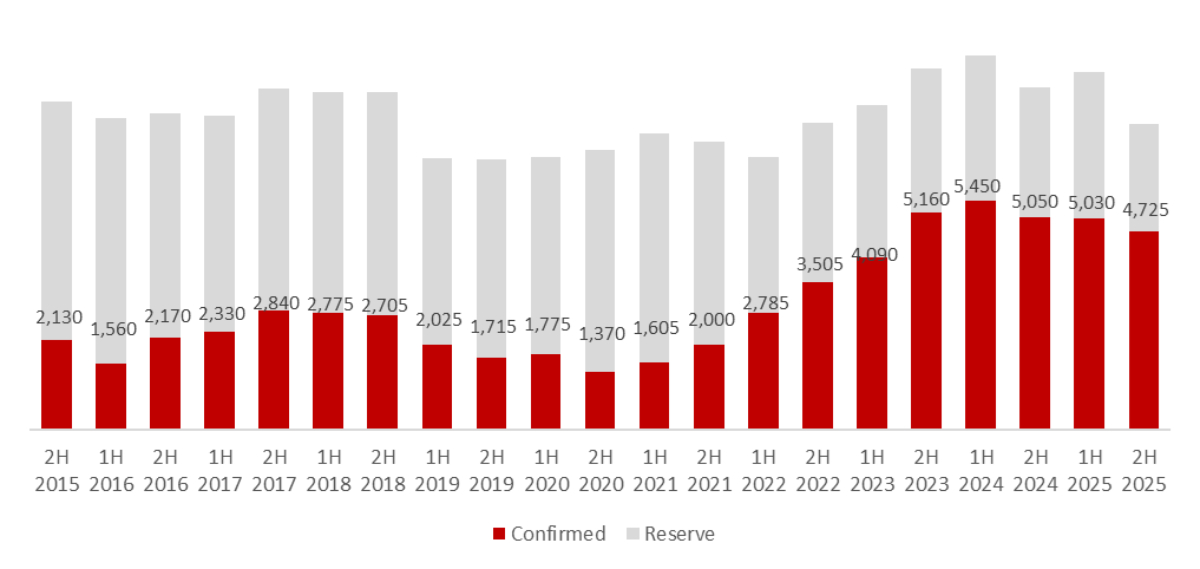
Source: URA, ERA Research and Market Intelligence
Where are the promising sites?
The Dunearn Road site will be the second private residential development launched following the announcement of Bukit Timah Turf City’s redevelopment plans earlier this year. The private residential site is nestled among the first upcoming HDB flats in Bukit Timah, and we expect the future residents to benefit from ample amenities as the area undergoes transformation. Demand for this site will be interesting to watched based off the performance of the prior Dunearn Road site that will close in late June.
The other CCR site in Newton at Bukit Timah Road will also draw in developer’s interest due to its strong location adjacent to Newton MRT interchange. The location will draw in both owner occupiers and investment buyers, due to its unique central location located not only near offices and the CBD, but also family friendly amenities and a good nearby primary school in ACS Junior.
Among the sites unveiled in the 2H 2025 GLS slate, Dover Road stands out with the highest estimated residential yield of approximately 625 units, along with a commercial component of 3,000 sqm, which will introduce crucial amenities for residents. The site is suited likely for owner-occupiers and working families as its location offers better access to one-north MRT station and a cluster of well-regarded schools. These include Anglo Chinese Junior College and Fairfield Methodist School (Primary and Secondary).
Lastly, the two EC sites at Woodlands Drive 17 and Miltonia Close will also be on the radar for developers. There has been a large influx of EC supply in the North, and developers will have to balance and consider their strategy when it comes to choosing the right site for development.
Bukit Timah Road – 340 units

Source: URA
This site is located adjacent to Newton MRT, which is a key stop for commuters travelling to and from the North-South and Downtown lines.
This CCR site boasts a medium to large size of 340 units and could see demand from both owner occupiers and investment buyers, due to its proximity to the city centre, and for those working in the finance sector, which hold offices in the Newton/Buki Timah Road area.
The site will be within the 1km priority enrolment distance from Anglo Chinese School (Junior), which is a definite plus for owner-occupier families. Amenities located close by are dense, with immediate dining options at Newton food centre, and access to multiple shopping malls in Novena, and Orchard just one stop away respectively.
Developers may show a warm interest in this prime Bukit Timah Road site, given limited competition due to the scarcity of new private home supply in the immediate vicinity. However, interest in the site could be moderated by its prime CCR location, and larger project size, which could spell higher risk than the other sites on this Confirmed List.
Bedok Rise – 380 units
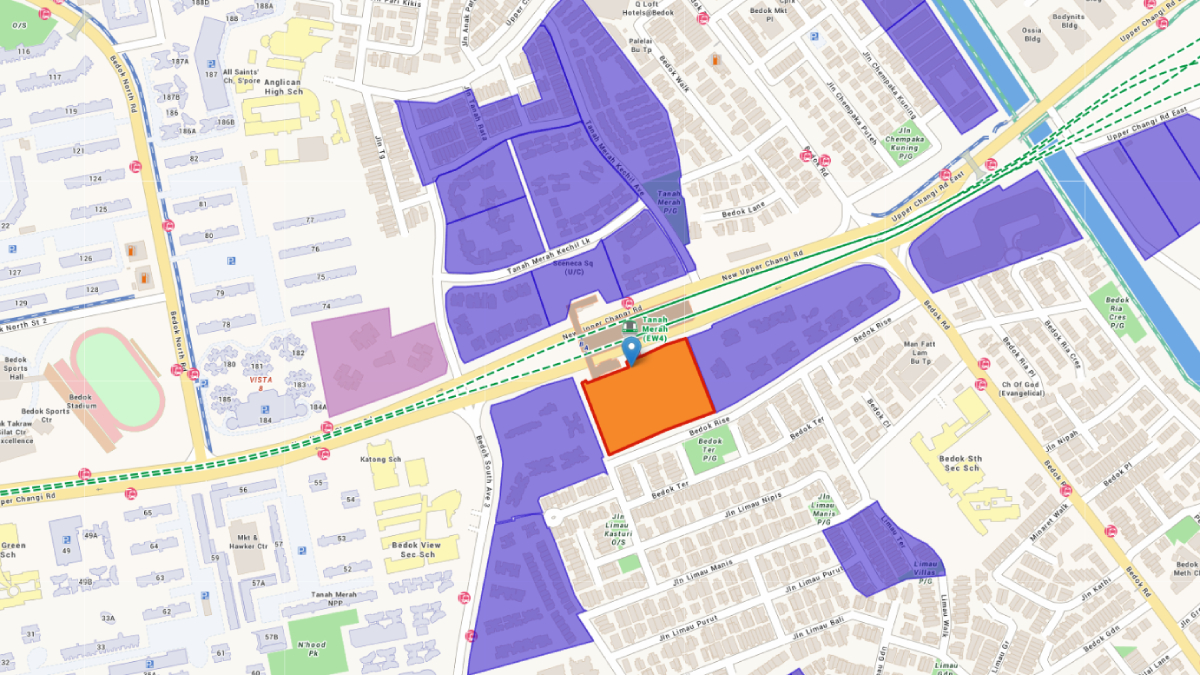
Source: URA
Bedok Rise, located just beside Tanah Merah MRT Station, is largely a private residential estate surrounded by condominiums and landed homes. It provides strong connectivity, being an interchange on the East-West Line and towards Changi Airport.
There is a shortage of new homes in Bedok, the last major launch was in January 2023, when Sceneca Residence made its debut. It has since sold 98.1% of its 268 units. Demand for homes in Bedok has been high, with the latest site at Bayshore Road setting a new record price psf for an OCR site when awarded for $1,420 psf ppr in March 2025.
The new mall at Sceneca Residence located across the street provides amenities while there are several schools in its vicinity, including Temasek Primary School, Bedok View Secondary School, Bedok South Secondary School and the Singapore University of Technology and Design (SUTD). There are also several commercial and industrial nodes such as Changi Business Park, Changi Airport and the future Changi East Urban District close by. Therefore, developers’ keen interest is expected for this site.
Woodlands Drive 17 (EC) – 560 units
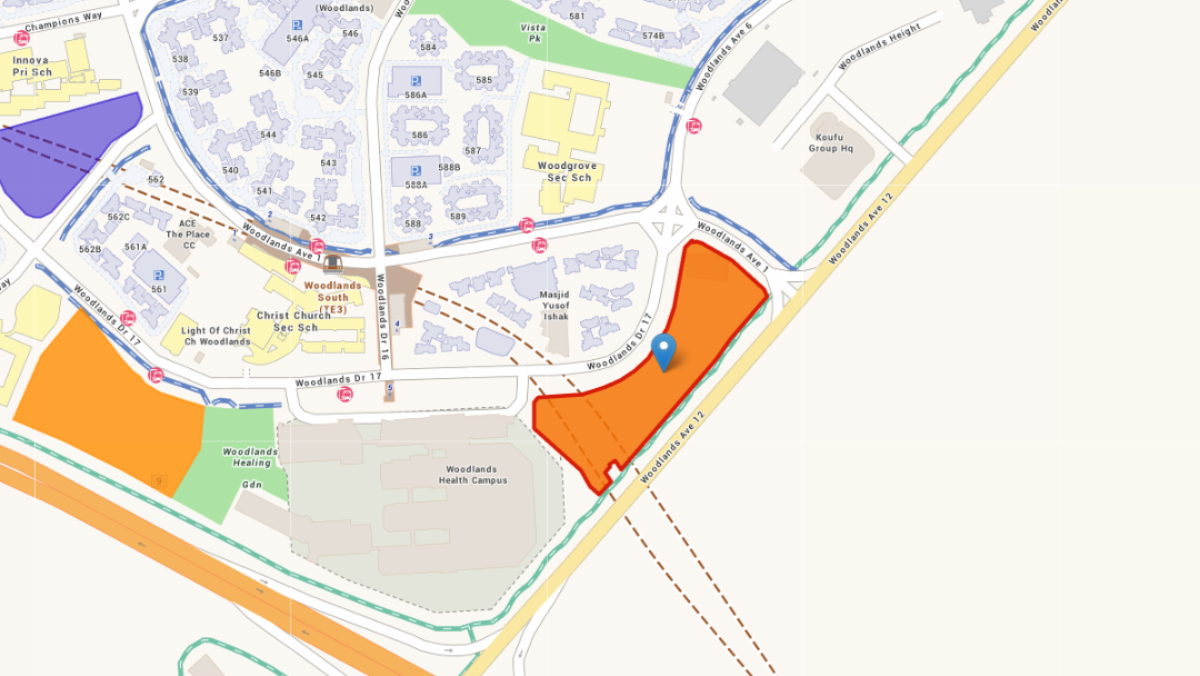
Source: URA
Among the two EC sites announced in this round’s GLS programme, this Woodlands Drive 17 site stands out as the premier option for upgraders in the North region. The location and name of this site might ring a bell, as a nearby EC site along the same road was launched for tender in 1H 2025.
Traditionally, ECs are located in less-prime areas relative to private developments, making them a more budget-friendly option in exchange for further distances from key amenities. However, this site will be located a walk away from Woodlands South MRT station, which enhances its connectivity to other locations on the Thomson-East Coast Line. Residents can also enjoy dining options at Woodlands Health Campus just next door.
The popularity of this site will largely depend on the bids received for the closing of the earlier Woodlands Drive EC, which would take place in August. Developers could wait for the results of the bidding process to plan or adjust their bidding strategy respectively. Additionally, this is the 4th EC site launched in the North region in the same year, which could further pace the demand. However, despite all this, we should definitely see a fairly competitive bidding process for this site, as EC sites generally offer lower risk for developers.
Dairy Farm Walk – 500 units
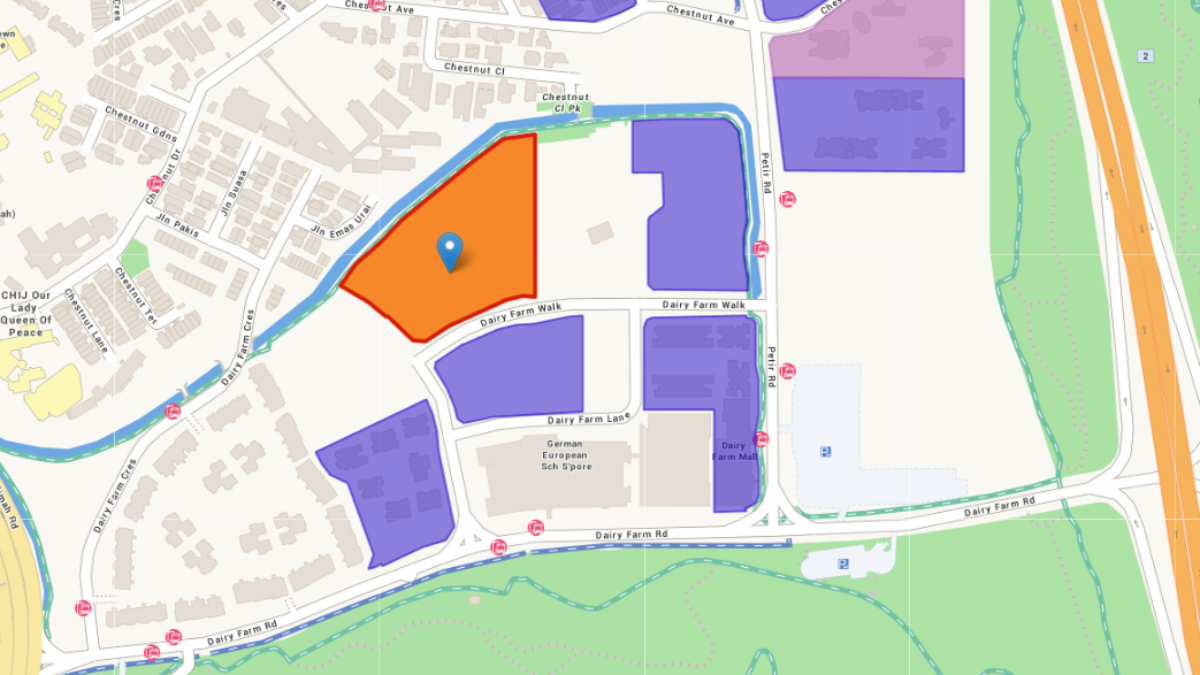
Source: URA
Located near Hillview MRT station, Dairy Farm has been transformed to become a new housing cluster. Amenities there include HillV2 and Dairy Farm Mall, with the Rail Mall being slightly further away.
Presently, there are eight private developments surrounding the MRT station. The last site, also along Dairy Farm Walk, was awarded in January 2025 for $1,020 psf ppr. It had drawn two bidders and when completed, it can yield up to 540 units. This would mean competition for buyers, with more than 1,000 units available.
It is unlikely for developers to be competing strongly for this site.
Dunearn Road – 370 units
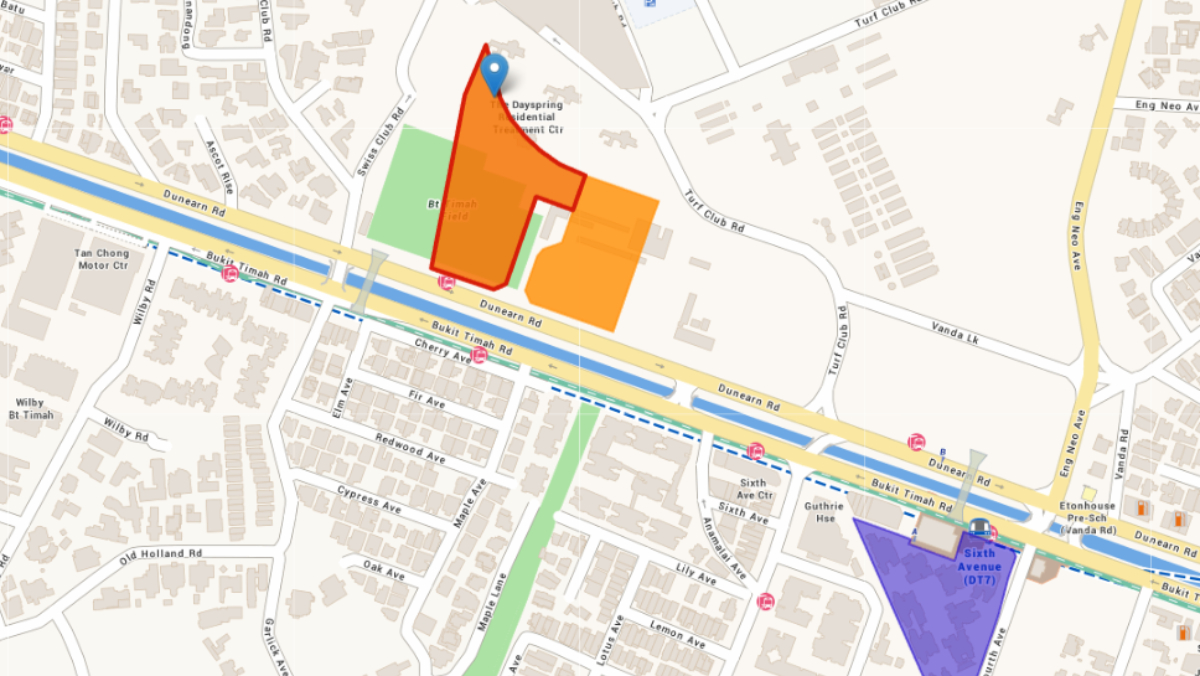
Source: URA
The Dunearn Road is the second site to be announced in the vicinity, following the debut of a previous site in the 1H 2025 Confirmed List. The tender for the earlier site will close in late-June this year, and developers could take cue from the results in their bids for this plot.
Demand for this site will be fuelled mainly by the Turf City transformation. This could encourage older residents from nearby landed estates to consider this as a right-sizing opportunity. The site is also close to Sixth Avenue MRT station.
Dover Road – 625 units
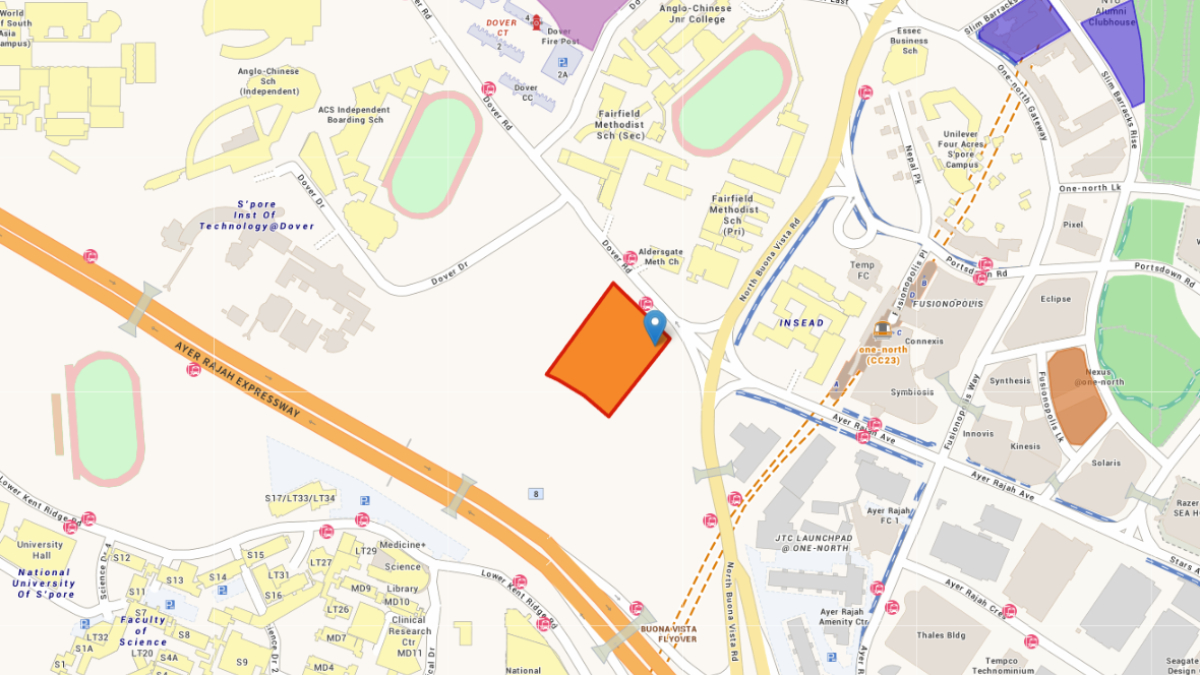
Source: URA
Among the sites unveiled in the 2H 2025 GLS slate, Dover Road stands out with the highest estimated residential yield of approximately 625 units, along with a commercial component of 3,000 sqm. The site is also situated closely to the one-north innovation district, much like recent GLS sites, such as Media Circle (Parcels A and B).
However, Dover Road is more likely to appeal to aspiring owner-occupiers and working families as its location offers better access to one-north MRT station and a cluster of well-regarded schools. These include Anglo Chinese Junior College and Fairfield Methodist School (Primar and Secondary).
The site also carries historical value as it sits on the former Dover HDB estate which consisted of Blocks 30-39. This marks the maiden residential development on the plot since its demolition in 2018 – 2019.
Tanjong Rhu Road – 525 units
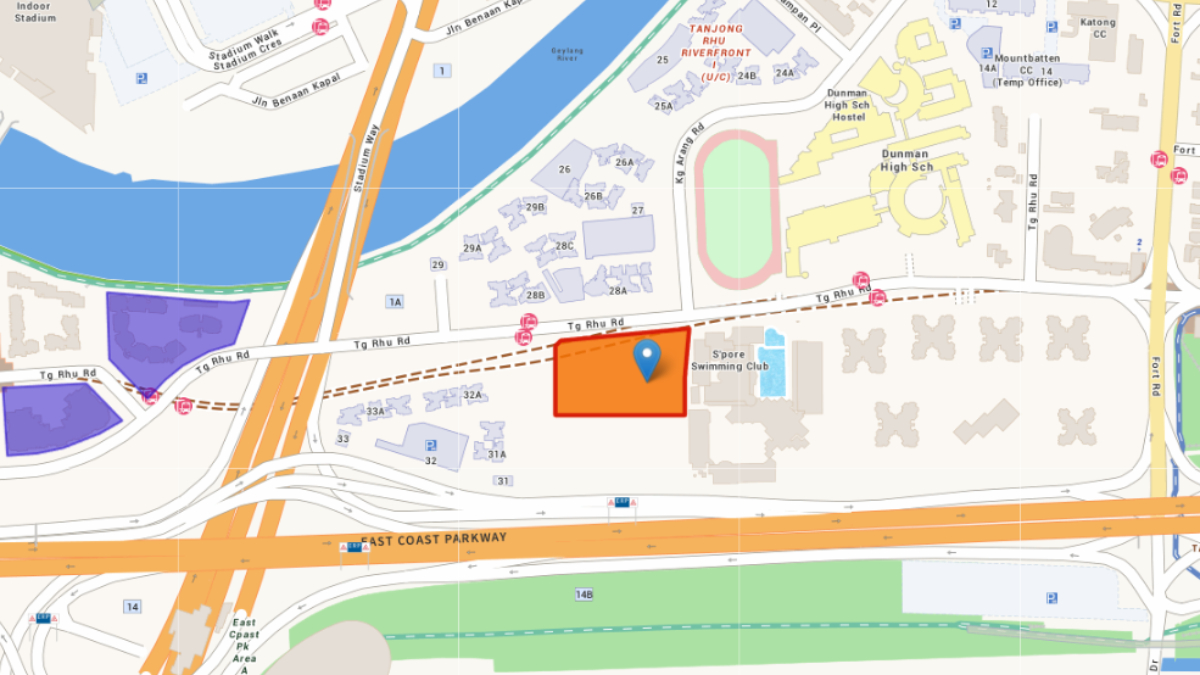
Source: URA
This is the first residential GLS plot to be released along Tanjong Rhu Road in nearly three decades since 1997, making it a rare opportunity for developers seeking to cater to sustained upgrader demand in the city-fringe locale.
Its attractiveness is further enhanced by its proximity to key infrastructure and amenities. These include Tanjong Rhu MRT station on the Thomson-East Coast Line, offering seamless access to the CBD, and the nearby Singapore Sports Hub, which is part of the Kallang Alive master plan that is transforming the precinct into a major sports and lifestyle destination.
Kallang Avenue – 450 units
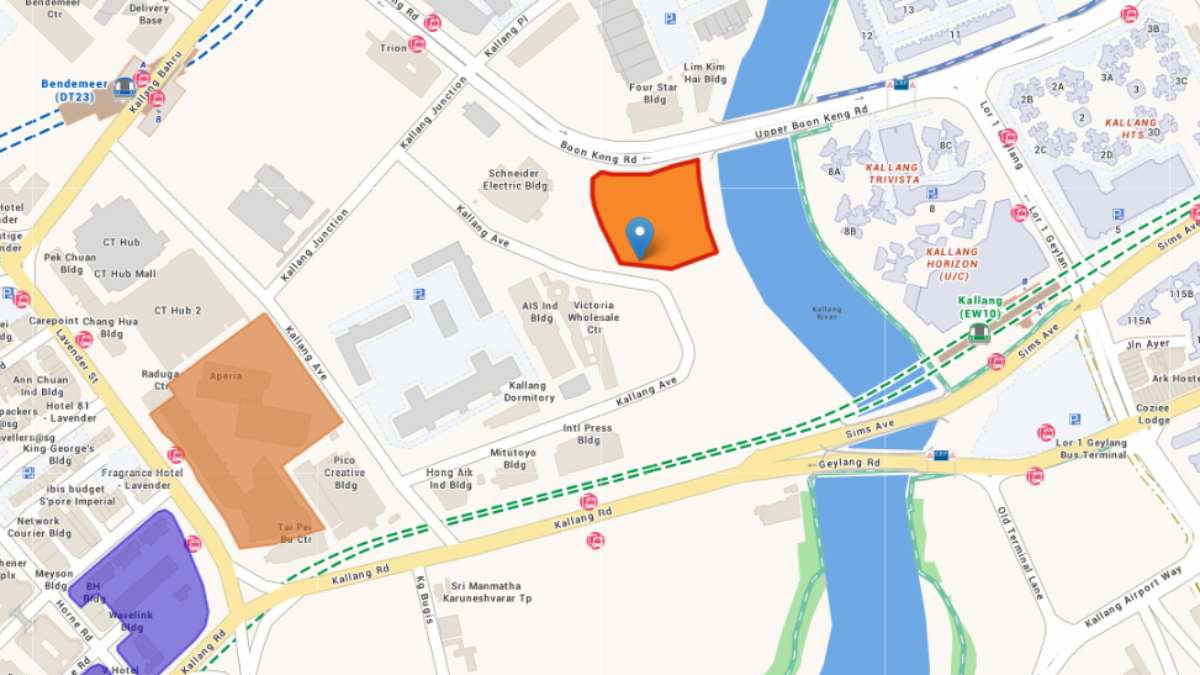
Source: URA
The Kallang Avenue site is within a 10-minute walk to both Kallang and Bendemeer MRT Stations. Some units will have unblocked waterfront views, overlooking Kallang River. There will also be a small commercial section within the development, that will provide amenities for residents.
Located between Kallang Avenue and Boon Keng Road, this site would be a potential site for HDB upgraders. The newer HDB estates have yielded several million-dollar flat in the past few years.
Despite being located within an industrial estate, developers are likely to be keen on this site.
Lentor Central – 580 units
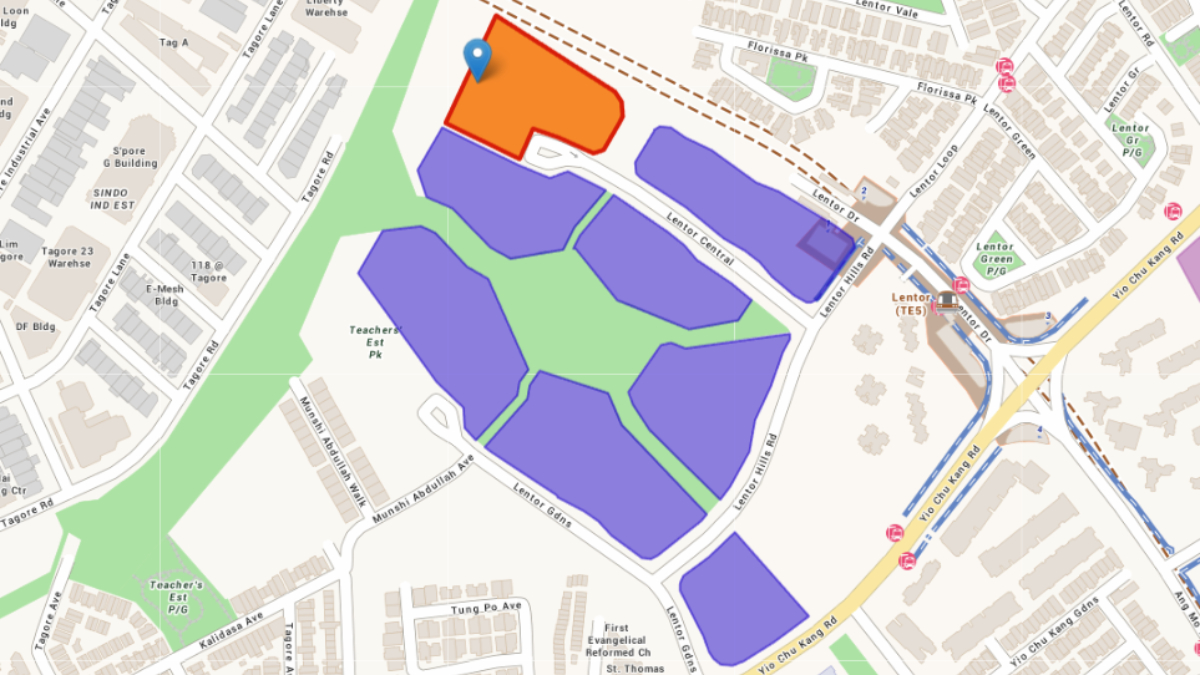
Source: URA
Lentor, being located within the established and centrally located Ang Mo Kio town, has ample amenities and strong connectivity. All seven sites that were previously launched have been sold. Hence, the Lentor Hills estate saw a fresh injection of seven GLS sites initially. Despite yielding close to 3,500 units in total, there was still steady demand across all the projects.
Most recently, Lentor Central Residences sold 93% of its 477 units at its launch. Till date, excluding the latest Lentor Gardens site that was awarded in April 2025, there are less than 100 units remaining.
We can expect developers to closely watch this site, as it has promised a strong demand from both HDB upgraders in nearby towns, and right-sizers from the surrounding landed estates, due to its convenient location and nearby MRT within walking distance.
Miltonia Close (EC) – 430 units
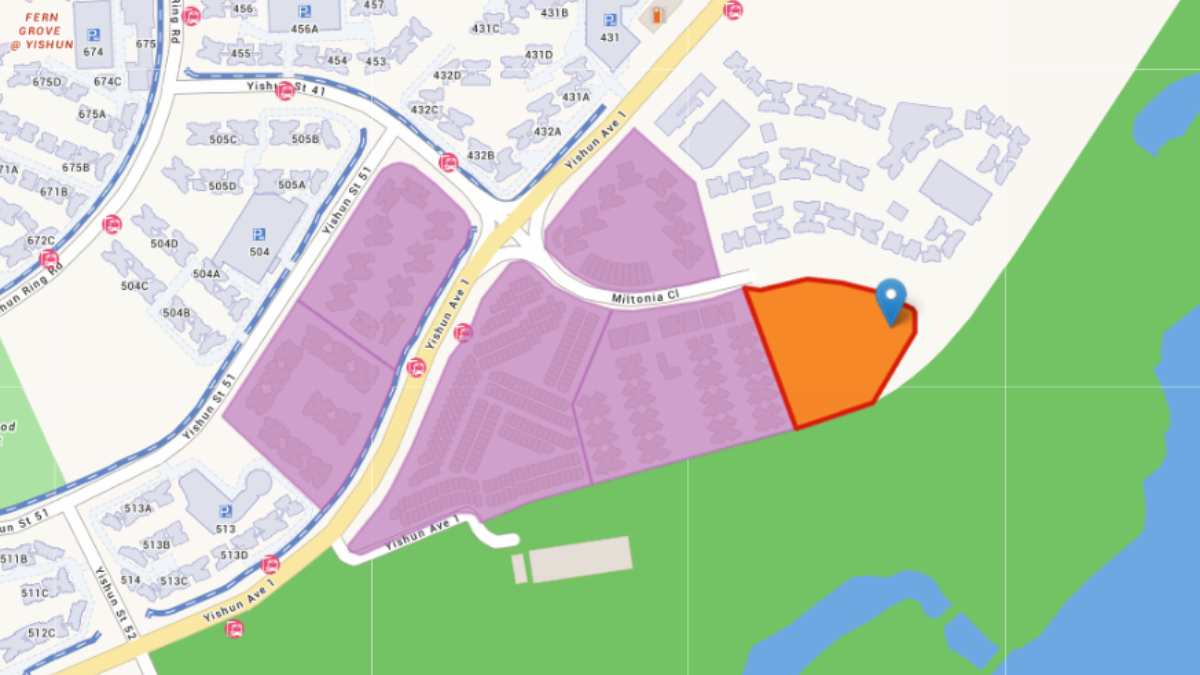
Source: URA
The second EC GLS site of this half, the Miltonia Close EC site will be located off Yishun Ave 1, adjacent to Lower Seletar Reservoir Park.
The location attributes of this site are less desirable compared to the other EC site at Woodlands Drive 17. The biggest difference would be transport connectivity, where residents of this future site would have to spend 15-20 minutes on a bus commute to the nearest MRT of Khatib – whereas the Woodlands Drive site is closer to the MRT station.
However, this site promises a few unique attributes, such as a greenery and waterfront view overlooking the reservoir and park connector, as well as its location away from the main road surrounded by other private developments.
There should be a strong demand for ECs in Yishun, as the most recent EC in the town, North Gaia sold out all of its units earlier in the year. With the HDB focusing development in Yishun, particularly the upcoming Chencharu precinct with shorter waiting time projects, this could introduce future demand for the project.
Disclaimer
This information is provided solely on a goodwill basis and does not relieve parties of their responsibility to verify the information from the relevant sources and/or seek appropriate advice from relevant professionals such as valuers, financial advisers, bankers and lawyers. For avoidance of doubt, ERA Realty Network and its salesperson accepts no responsibility for the accuracy, reliability and/or completeness of the information provided. Copyright in this publication is owned by ERA and this publication may not be reproduced or transmitted in any form or by any means, in whole or in part, without prior written approval.
This article was first published on EdgeProp, featuring expert insights and opinions from Mr. Marcus Chu, CEO of ERA Singapore, ERA Asia Pacific & APAC Realty.
With 29 years of experience in real estate, including four years as the CEO of ERA Singapore, I have had the unique opportunity to witness firsthand the numerous transformations that have influenced Singapore’s real estate scene.
Over numerous building projects, Singapore’s master planning has reshaped our skyline and established a solid foundation for our nation’s and its people’s ongoing development. At the same time, our government has shown a strong commitment to maintaining housing stability by directly addressing market challenges.
Singapore has shown remarkable resilience despite many obstacles, from addressing early land shortages to managing recent pandemic-fuelled supply disruptions.
Similarly, major financial crises have provided transformative insights that led to the implementation of structural protections such as the total debt servicing ratio (TDSR) and the mortgage servicing ratio (MSR).
A resilient market, now tested
As Singapore celebrates its 60th anniversary this year, many reasons exist to take pride in our policy and nation-building accomplishments.
Nevertheless, ongoing success also requires honest reflection and adaptability. Just like past events and demographic shifts have greatly transformed our property market, new trends will continue to emerge — and they will require proactive engagement to ensure local housing stays inclusive and accessible.
In the last 20 years, average household incomes in Singapore have increased by 111%. Yet, this uptick in earnings has been outpaced by a booming property market, with the Private Property Price Index climbing 148% and the HDB Resale Price Index soaring by an astonishing 169% during the same period.
Median household income versus property price growth (2000 – 2024)
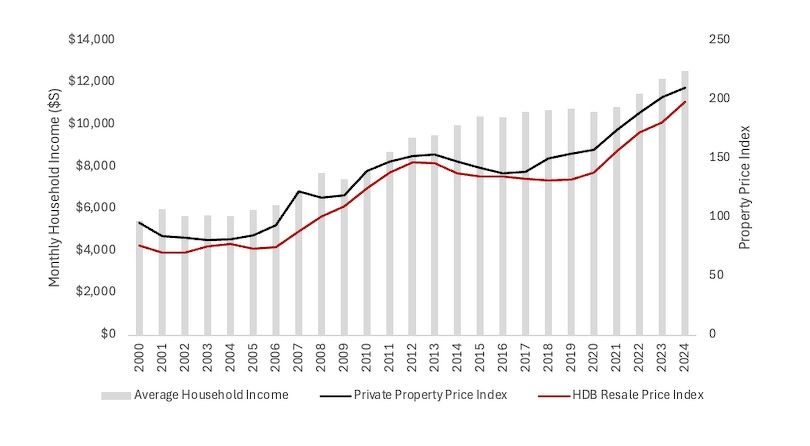
Source: SingStat, URA, HDB, ERA Research & Market Intelligence
The widening gap between income and prices has presented significant challenges to affordability for those seeking to purchase private homes. Although the increase in HDB resale prices has been advantageous for some, many struggle to upgrade due to the parallel rise in private property values.
Executive condominiums (ECs) have become a practical middle-ground choice in this climate. They offer premium condo-style living at a subsidised price in return for stricter eligibility requirements, including an income ceiling of $16,000 and limits on the MSR.
However, despite the continued strong allure of ECs, younger first-time homebuyers now face a steeper path to entry due to rising EC prices and higher upfront cash. In contrast, second-timers often have accumulated housing equity to leverage, and with the deferred payment scheme, it becomes easier for them to purchase an EC.
As concerning as these affordability pressures may be, they are not the only challenges for today’s homebuyers, especially given the broader socio-economic patterns reshaping Singapore’s housing market.
Forces reshaping housing in the next decade
With one in four Singaporeans projected to be 65 or older by 2030, policymakers must address the impending silver tsunami and its extensive socio-economic implications. For instance, alongside this demographic shift, we have observed the growing influence of wealth transfers in driving housing demand.
We have seen a growing number of private homeowners right-sizing in hopes of tapping into their housing equity for retirement while still owning a property that holds value. Simultaneously, some younger homebuyers are now benefiting from parental wealth transfers. It underscores the generational wealth disparity and the widening gap between income growth and housing price appreciation.
On the supply side, rising land costs are also contributing to the growth of private housing prices. Locally, developers acquire land through the Government Land Sales (GLS) programme via a competitive bidding process, where the highest bidder is typically awarded the tender, provided the bid is above the reserve price. This dynamic often drives land prices upward, and more so in desirable locations.
Separately, as part of Singapore’s efforts to meet net-zero emissions by 2050, the government’s carbon pricing strategy will see the carbon tax rise to $25 per tonne of carbon dioxide equivalent (tCO2e) in 2024 and 2025 and $45 tCO2e in 2026 and 2027, with a view to reaching $50–80 tCO2e by 2030. These hikes are set to drive construction costs up, potentially impacting future housing prices.
Better to invest in a home today, instead of waiting for tomorrow
With the abovementioned trends so deeply entrenched in our real estate market, home prices are anticipated to remain stable. Hence, instead of finding the “perfect time” to enter the property market, the wiser approach is to maximise your time. After all, real estate has consistently shown its long-term investment potential with its track record of steady appreciation over time.
For young homebuyers, the most logical first step is to secure a Build-to-Order (BTO) flat as their starter home. BTOs come with a range of subsidies and grants that significantly reduce the cost of homeownership. That will set the stage for future asset progression opportunities.
Buyers should also remain open-minded to take advantage of the first-mover advantage. After all, Singapore’s efficient urban planning ensures that no area is left underdeveloped for long. Identifying these emerging neighbourhoods in advance allows buyers to capitalise on attractive entry prices and potentially benefit from future growth as the area matures and infrastructure improves.
Therefore, planning, patience, and foresight are the keys to unlocking a home and acquiring growth opportunities in real estate. At the same time, buyers should also bear in mind that your journey in real estate isn’t a plan for tomorrow — it’s a future that starts now.
Disclaimer
This information is provided solely on a goodwill basis and does not relieve parties of their responsibility to verify the information from the relevant sources and/or seek appropriate advice from relevant professionals such as valuers, financial advisers, bankers and lawyers. For avoidance of doubt, ERA Realty Network and its salesperson accepts no responsibility for the accuracy, reliability and/or completeness of the information provided. Copyright in this publication is owned by ERA and this publication may not be reproduced or transmitted in any form or by any means, in whole or in part, without prior written approval.
Are Executive Condominiums (ECs) still an affordable option for home buyers today? They may not be since as explained in our last EC article, buyers are constrained by the amount of loan which they can take up for their EC purchase. This is largely due to the income cap, stringent Mortgage Servicing Ratio (MSR) and Total Debt Servicing Ratio. Even with a monthly income of $16,000, buyers may qualify for a loan of up to $1 million, requiring them to cover the excess EC cost with cash and/or CPF. Amid rising EC prices, and a cap in loan quantum, EC buyers will now have to shell out a larger cash outlay.
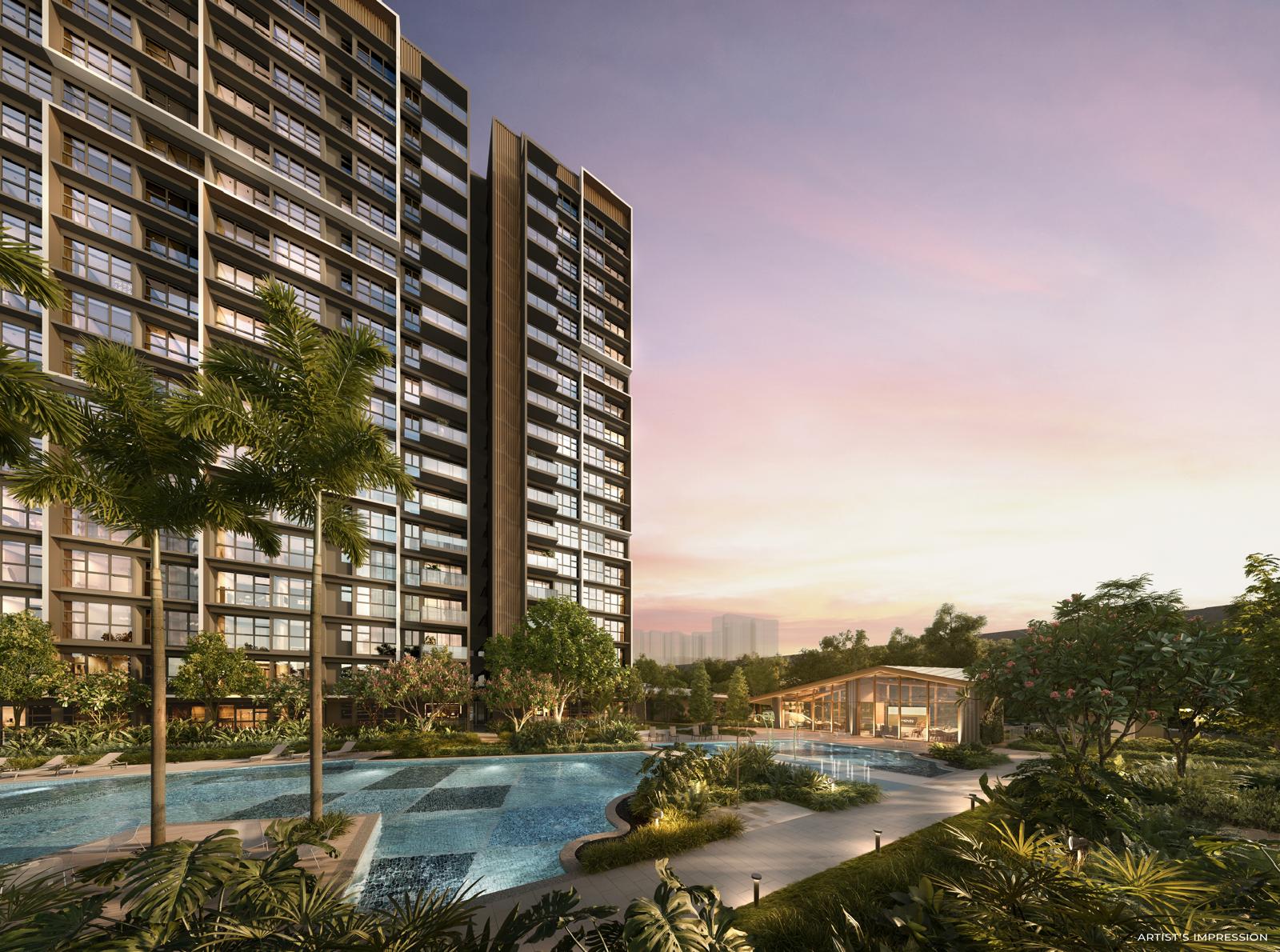
Despite so, many Singaporeans continue to gravitate towards ECs as they are perceived to be more value-for-money compared to private condos. In 2024, the median transaction price of a new Outside Central Region (OCR) condominium unit (900–1,000 sqft) was 42% higher than that of a similar executive condominium (EC) unit. Even at the lower price point, residents can enjoy similar lifestyle with security and full-fledged facilities such as swimming pools, gyms and function rooms.
Table 1: Price comparison between a new EC and OCR condo (900 – 1,000sqft) in 2024

Source: URA as of 22 Feb 2025, ERA Research and Market Intelligence:
Moreover, the lower purchase price will also translate to a smaller loan quantum, which in turn reduces interest costs. Eligible First-timer buyers may also receive up to $30,000 in grants to offset their down payment.
Impressive Sales Performances In Recent EC Launches
Lumina Grand, sold 53% of its units at an average price of $1,464 psf during its launch weekend. Similarly, Novo Place sold 57% of its 504 units at an average price of $1,654 psf at its launch in Nov-2024. When it opened for the second round of balloting for second timer buyers, Novo Place moved another 137 units, bringing it total sale to 88%.
Based on URA caveats, there were a total of 1,185 new EC transactions in 2024. With a limited number of EC launches each year, buyers turn to remaining EC supply. As of end-Jan 2025, the market saw the balance EC supply fall to merely 138 units.
What makes ECs so Attractive?
Despite the higher upfront costs, buyers are not deterred mainly for two reasons. The lower price aside, EC buyers do not need to dispose their existing home before their EC purchase. HDB upgraders do not incur the Additional Buyers’ Stamp Duty (ABSD) when buying a new EC.
Moreover, EC buyers may opt for the Deferred Payment Scheme (DPS) at a cost, where they only need to pay a deposit and deferred their loan till after the EC has been completed. In this way, the buyers will not need to service two mortgages while waiting for the new home.
With no ABSD payable and the availability of the DPS, HDB owners find it easier to upgrade to new ECs.
Why are ECs Becoming Increasingly Expensive?
Firstly, like other property developments, construction and labour costs have been rising. This problem was exacerbated by the Covid-19 pandemic, with tighter supply for goods worldwide. Higher inflation rate has added to developers’ cost. Construction firms also have to compete for a tighter pool of workers with more public (such as the Cross-Island Line and HDB Build-to-Order flats) and private sector construction projects.
Secondly, land costs have also risen, with the continued strong demand for new ECs.
With the continued strong demand for new ECs, Developers were seen bidding more aggressively for EC sites. Between 2015 and 2024, the average EC land costs have risen 164%, from $287 psf ppr to $733 psf ppr. To illustrate a more recent example, the Tengah Garden Walk EC site, subsequently launched as Copen Grand, was awarded to a joint venture between City Development Group and MCL Land, at $603 per square foot per plot ratio (psr ppr) in 2021.
In Feb-2024, another EC site at Plantation Close was awarded to Hoi Hup Realty Pte Ltd and Sunway Developments Pte. Ltd. for $701 psf ppr, which works out to 16% higher than the Copen Grand site.
Chart 1: Land cost of ECs since 2015
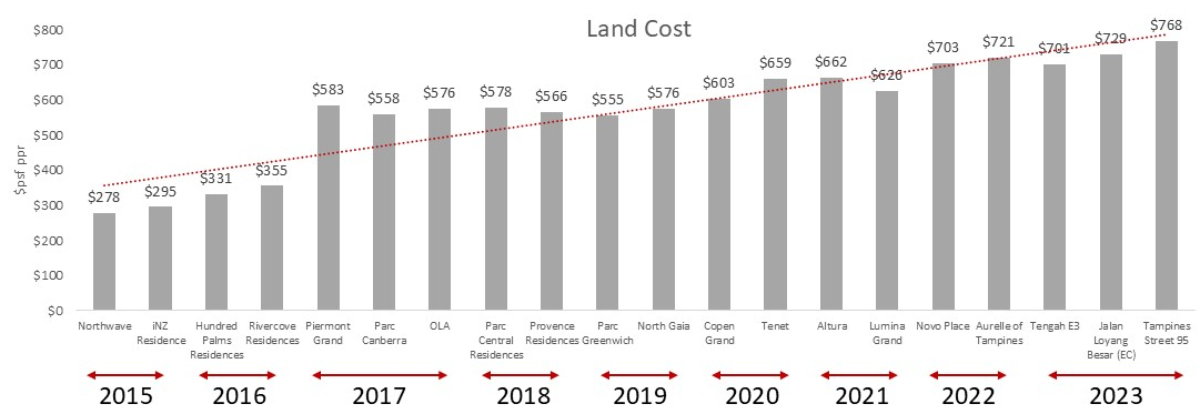
Source: URA, HDB, ERA Research and Market Intelligence
Thirdly, the harmonisation rule which took effect from 1 June 2023 means, developers are no longer allowed to sell non strata areas (e.g. void spaces and air-con ledges). As a result, developers have adjusted their selling price to account for the reduced sellable area, consequentially lead to a higher psf pricing.
Table 2: Existing launched ECs in the market

Source: ERApro as of 4 Feb 2025
However, fret not about the few remaining stock in the market, or the lack of new EC launches in the East. In 2025, there are three EC slated for launch with two in the East and one in the West.
Here are the EC Launches in 2025:
Aurelle of Tampines

Source: URA Space
Estimated launch: Preview in Feb 2025
Planning Region/Area: East/Tampines
Distance to Nearest MRT Station: 5-min walk to the upcoming Tampines North MRT Station
Number of Units: 760
Developer: Sim Lian Land Pte Ltd and Sim Lian Development Pte Ltd
The first EC launch of 2025, Aurelle of Tampines will be highly anticipated. This is the first EC launch in Tampines since Tenet. Neighbouring Aurelle of Tampines, Tenet sold 72% of its 618 units at its launch in December 2022.
People living in the east will be drawn to Aurelle of Tampines, notwithstanding that Tampines is a well-established town with amenities. By the time buyers can collect their keys, there will be four shopping malls and two community hubs in Tampines. The transport infrastructure is also comprehensive. Internally, it is served by various feeder bus services and will have four MRT stations.
Tampines is also a regional centre and has two industrial estates within, while being near to other commercial nodes nearby at Changi Business Park, Changi Aviation Park and Changi Airport.
Located in the core of Tampines North, a new estate within Tampines, Aurelle of Tampines will be within a 5-minute walk from the upcoming Tampines North Integrated Transport Hub. There will be seamless connection between the MRT station, the air-conditioned bus interchange, a community club, a hawker centre, and a new mall (Parktown Tampines).
Tampines North MRT Station, on the upcoming Cross-Island Line, is one, three and six stops from Pasir Ris, Hougang and Ang Mo Kio Interchange respectively. This gives owners easy access to other parts of Singapore.
Plantation Close GLS

Source: URA Space
Estimated launch: 2Q 2025
Planning Region/Area: West/Tengah
Distance to Nearest MRT Station: 7-min walk to upcoming Tengah Park MRT Station
Number of Units: est. 560
Developer: Hoi Hup Realty Pte Ltd and Sunway Developments Pte Ltd
Located in Tengah, an up-and-coming estate designed for smart, sustainable living, Plantation Close EC residents will enjoy ample recreational and green spaces in their neighbourhood.
The upcoming EC site sits beside Novo Place EC, a short walk from the future Tengah Park MRT. Residents will have easy access to Jurong Lake Gardens, the Innovation District, and Nanyang Technological University via the Jurong Regional Line. Drivers benefit from direct access to the Pan-Island Expressway.
For amenities, residents can visit Plantation Plaza, a one-stop hub with a supermarket, food court, F&B outlets, enrichment centres, and service shops for residents’ everyday needs.
Given these advantages, it’s no surprise Novo Place has sold 90.9% of its units within three months of its launch. Those who missed out on their desired unit can consider this new EC, which shares the same developer.
However, while offering similar features, this EC is slightly farther from Tengah Park MRT and sits next to the PIE.
Jalan Loyang Besar GLS
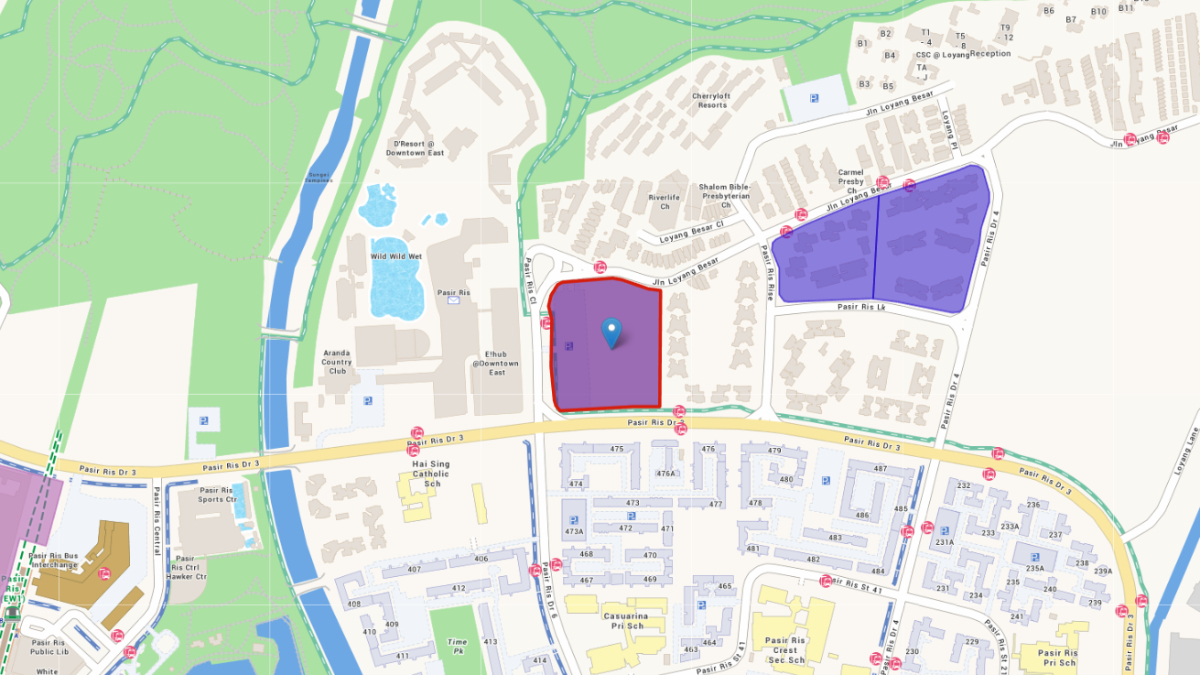
Source: URA Space
Estimated launch: 4Q 2025
Planning Region/Area: East/Pasir Ris
Distance to Nearest MRT Station: 3 bus stops to Pasir Ris MRT Station
Number of Units: est. 710
Developer: CNQC Realty (Progressive) Pte Ltd, Forsea Residence Pte Ltd, and ZACD Laserblue Pte Ltd
Jalan Loyang Besar EC, located in Pasir Ris, offers unmatched convenience just opposite Downtown East, Pasir Ris Park, the beach, and several schools. With E!Hub @ Downtown East across the road, families have easy access to enrichment centres, play areas, preschools, and childcare services. The mall also features two supermarkets, eateries, and a cinema. Pasir Ris Sports Centre and Hawker Centre are just 700m away.
For connectivity, the EC is two bus stops or a 1km walk to Pasir Ris MRT interchange, linking the East-West and upcoming Cross-Island Lines.
Families with school-going children benefit from two primary schools within 1km—Casuarina and Pasir Ris Primary—plus four secondary schools, a junior college, and an international school nearby.
With no EC launches in Pasir Ris since 2013, pent-up demand from east-side residents is likely.
Have any of these new ECs piqued your interest? If so, speak to an ERA Trusted Adviser today.
Disclaimer
This information is provided solely on a goodwill basis and does not relieve parties of their responsibility to verify the information from the relevant sources and/or seek appropriate advice from relevant professionals such as valuers, financial advisers, bankers and lawyers. For avoidance of doubt, ERA Realty Network and its salesperson accepts no responsibility for the accuracy, reliability and/or completeness of the information provided. Copyright in this publication is owned by ERA and this publication may not be reproduced or transmitted in any form or by any means, in whole or in part, without prior written approval.
New year, new launches, and new opportunities to find your dream home.
Following a lull in the earlier months of 2024, November saw no fewer than six new private residential developments hitting the market all at once. These include The Collective at One Sophia, Chuan Park, Emerald of Katong, Union Square Residences, Nava Grove, and Novo Place (Executive Condominium) – all of which saw heathy take-up rates on their respective launch weekends.
However, despite the strong demand exhibited by condo-seekers, it’s still early days as to whether such a level of interest is sustainable next year. Still, in any case, prospective private home buyers in Singapore will definitely have more new launches to look forward to as 2025 unfolds.
What are the new private home launches coming in 2025?
With 24 new private home developments, as well as three EC projects, anticipated to launch next year, 2025 is already shaping up to be a year of opportunity for owners and investors alike.
Below, a quick summary of these upcoming launches, which will bring close to 11,000 new private homes and 2,000 ECs to the market:
Table 1: New private home launches in 2025
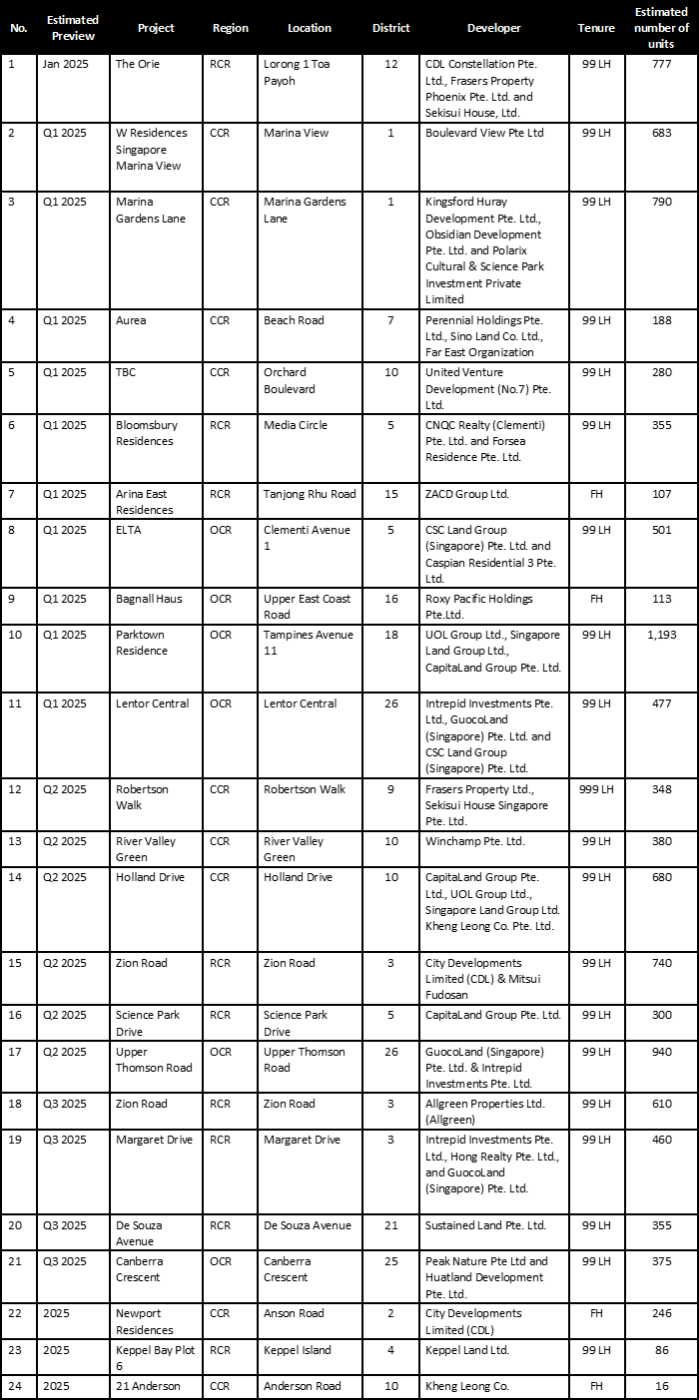
Table 2: New executive condominium launches in 2025
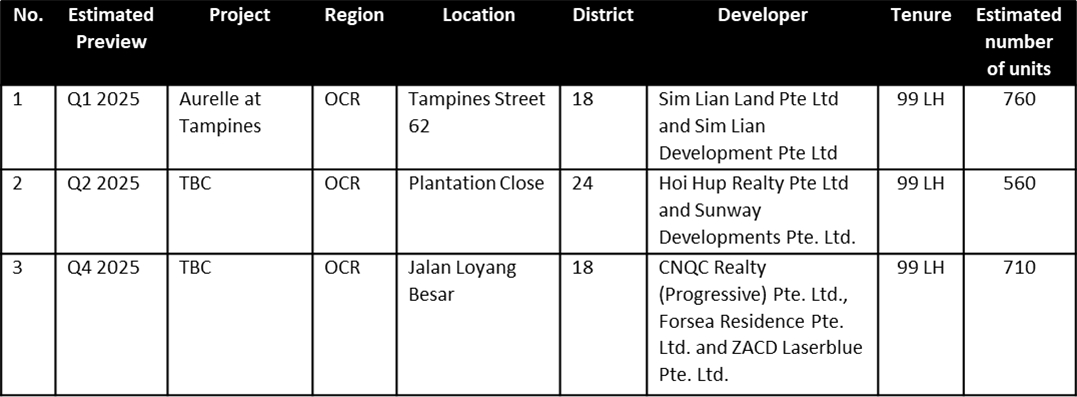
Source: ERA Project Marketing, ERA Research and Market Intelligence
Core Central Region (CCR) launches in 2025
By and large, 2024 was a subdued year for CCR launches. In the first nine months of the year, developers launched just 313 new private homes in Singapore’s city core – a stark contrast to the 941 units in the RCR and 1,968 units in the OCR.
However, a turnaround is on the cards in 2025, with approximately 3,600 units across nine CCR launches projected for the full year.
Near Singapore’s Central Business District (CBD) and Marina Bay, homebuyers can expect to see the launch of W Residences – Marina View, as well as a yet-unnamed development at Marina Gardens Lane.
W Residences – Marina View is a premium development offering some 680 residences with unparalleled connectivity to three major expressways (Marina Coastal Expressway, Ayer Rajah Expressway, and Central Expressway) and multiple MRT stations (Shenton Way, Downtown, Marina Bay, Tanjong Pagar, Bayfront).

On the other hand, the upcoming launch at Marina Gardens Lane will be the first of its kind, being a 790-unit development close to Marina Bay Sands and Gardens by the Bay. Moreover, its proximity to the future Marina South MRT station promises great convenience for future residents.
Further away from the CBD, homebuyers can look forward to several small to mid-sized launches at four sites. These include River Valley Green (380 units), Holland Drive (680 units), Orchard Boulevard (280 units), and Aurea (188 units).
River Valley Green’s future launch is within reach of Great World MRT station and Great World City shopping centre, while also possessing strong rental prospects due to its CCR location. Meanwhile, Holland Drive’s location in District 10 makes it an appealing option for condo-seekers who prize proximity to both the city core and green spaces in Singapore.
Though it comprises just 280 units, the upcoming launch at Orchard Boulevard is big on convenience, as it has a direct link to Orchard Boulevard MRT station on the Thomson-East Coast Line. Not to mention, it is near the Orchard Road shopping belt which would give future residents access to a multitude of retail, dining and entertainment options.

Situated at the site of the former Golden Mile Complex, Aurea follows in the footsteps of its predecessor by offering residents the unique opportunity to live, work, and play at Beach Road. Besides providing a fresh supply of 188 new private homes to the area, Aurea’s launch will also be joined by an array of new retail shops, healthcare facilities and offices at The Golden Mile – a sister development for commercial use.
Rest of Central Region (RCR) launches in 2025
Not unlike the CCR, the RCR will see a total of nine projects making their debut in 2025. Collectively, these new launches will bring a fresh supply of 3,790 units to city fringe locations, such as Toa Payoh, Queenstown, and River Valley.
Notably, The Orie will make its debut in January, marking Toa Payoh’s first new launch in almost ten years since Gem Residences in 2015. Consequently, prospective buyers can anticipate stiff competition during The Orie’s launch, stemming from a potent combination of pent-up demand and limited supply in the neighbourhood.
Moreover, this future 777-unit development will be sited along Toa Payoh Lorong 1, which places it in close proximity of Braddell MRT station, several food centres, and notable educational institutions, including Pei Chun Public School and CHIJ Primary (Toa Payoh).

Over in Queenstown, condo-seekers can look ahead to a future mid-sized development at Margaret Drive, with a possible launch in 3Q 2025.
Said project is expected to feature a total of 460 units and boasts attractive attributes. These include its close proximity to Queenstown MRT station, Queenstown Public Library, as well as Margaret Drive Hawker Centre. Additionally, it lies within a 1km radius of Queenstown Primary School and Queensway Secondary School.
Similarly, 2025 is shaping up to be a thriving year for the River Valley precinct – with not one, but two new launches situated at Zion Road. Of these two projects, one (Zion Road – Parcel A) is on track for a 2Q 2025 launch and is earmarked for development as a pilot site for long-stay serviced apartments, while the other (Zion Road – Parcel B) could make its debut in 3Q 2025 with 610 private homes in total.
Outside Central Region (OCR) launches in 2025
While the OCR will have fewer launches than other regions, with only six private residential projects in 2025, it is still expected to deliver a comparable total of approximately 3,600 new homes. These projects are located in popular OCR locales, including Tampines, Clementi, Lentor, and Upper Thomson.
In particular, Parktown Residence stands out as the largest OCR project amongst next year’s upcoming launches. Comprised of 1,193 units, this mega-development in Tampines will be developed as an integrated project, giving residents convenient access to a bus interchange, community club, eateries, as well as the future Tampines North MRT Station on the Cross-Island Line.
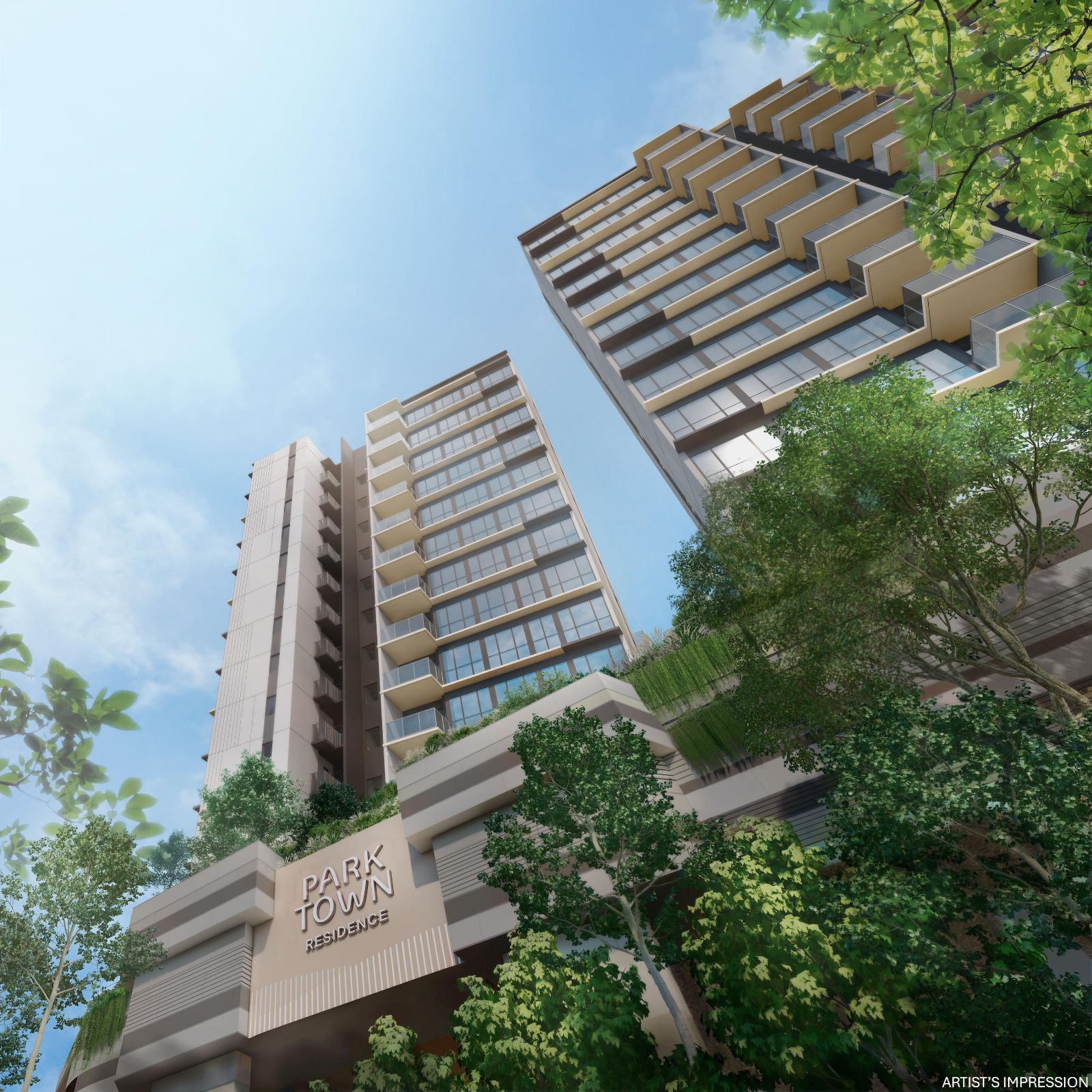
Over at Clementi, Elta – a 501-unit, 99-year development – is slated for a first quarter launch. The area has previously seen a string of successful launches with Clavon and Clement Canopy achieving over 70% take-up rates on launch day. History could repeat, given Elta’s proximity to a well-rounded mix of reputable schools (e.g. Nan Hua High School, NUS High School of Mathematics and Science), convenient amenities (e.g. Clementi Mall, Clementi 448 Market & Food Centre), and transport nodes (e.g. Clementi MRT station).
Up North, Lentor will be seeing its sixth new launch in Lentor Central Residences. Since 2022, the private residential enclave has welcomed Lentor Modern, Lentor Hills Residences, Hillock Green, Lentoria, and Lentor Mansion, all of which have seen varying levels of success during their respective launches.
As of November 2024, most of the abovementioned developments have achieved solid take-up rates ranging from 65% to 98%, with Lentor Modern being fully sold. Hence, given this combination of strong demand and limited remaining stock, there’s a strong likelihood that future homes at Lentor Central Residences will also attract significant interest.
Meanwhile, 2Q 2025 could mark the launch of a large 940-unit development at Upper Thomson Road. The site of this upcoming condo project sits within walking distance of Springleaf MRT station, and is also closely located to MacRitchie Reservoir. This means that future residents can enjoy the best of both worlds: efficient transport connectivity to urban areas, as well as proximity to green spaces nearby.
Executive Condominium launches for 2025
In contrast, 2025 is expected to bring a surge in EC supply, with approximately 2,030 units across three launches – Aurelle of Tampines (760 units), Plantation Close (560 units), and Jalan Loyang Besar (710 units). This could also potentially mark the highest number of EC dwellings to be launched in a year since 2014, when 2,505 units made their debut.
Aurelle of Tampines is situated near the upcoming Tampines North MRT station, as well as Tenet, a popular EC that sold 72% of its units on launch day. Tenet’s performance was largely thanks to its location in a well-established town – an advantage that Aurelle could also benefit from.
Likewise, both future ECs at Plantation Close and Jalan Loyang Besar hold appeal as well. The Plantation Close EC is located within Tengah, which is envisioned to be developed as a futuristic new town under URA’s West Region Master Plan. As for the future EC at Jalan Loyang Besar, it is within reach of notable amenities including Pasir Ris Park and Downtown East shopping mall, while also being the first new EC in Pasir Ris since 2012.
In Closing
With new projects popping up all across the island, 2025 is looking to be buyers looking for private homes or ECs that suit their specific needs, budgets, and preferences. Whether it’s premium mixed-use developments in the heart of the city or cost-effective homes in suburban Singapore, there’s something for everyone.
To get one step closer to securing your dream home in 2025, be sure to reach out to an ERA Trusted Adviser today for help in navigating your property journey!
Disclaimer
This information is provided solely on a goodwill basis and does not relieve parties of their responsibility to verify the information from the relevant sources and/or seek appropriate advice from relevant professionals such as valuers, financial advisers, bankers and lawyers. For avoidance of doubt, ERA Realty Network and its salesperson accepts no responsibility for the accuracy, reliability and/or completeness of the information provided. Copyright in this publication is owned by ERA and this publication may not be reproduced or transmitted in any form or by any means, in whole or in part, without prior written approval.
For Singaporeans, the Executive Condominium (EC) presents an opportunity to enjoy all the benefits of a private property: owners get to enjoy all of the prestige, privacy, and facilities associated with a typical condo, but at a more accessible price point
The EC housing concept is unique to Singapore, and was introduced in 1995, to “satisfy the demands of those who aspire to own private property but cannot afford to do so”. This enables ‘sandwich-class’ Singaporeans to achieve their aspiration of owning a private home. To balance cost and affordability, many new EC projects are located in young housing estates.
That said, there are several catches. EC buyers are subject to a monthly household income cap of $16,000 and a mandatory Minimum Occupation Period (MOP) of 5 years. Even so, after fulfilling the MOP, owners can only sell their EC to Singaporeans and Singapore Permanent Residents.
ECs can eventually be sold to foreigners, but only after they become fully privatised after a 10-year period. This degree of resale flexibility is a significant reason why ECs are such a useful asset and a fantastic choice for a first home.

Given the higher price point compared to HDB flats, most EC purchasers fall within the monthly household income bracket of between $14,000 and $16,000. This group of buyers does not qualify for Build-to-Order (BTO) flats, and has to either explore resale HDB flats or private homes as alternatives.
Naturally, this makes ECs an attractive option, which may prove to be a wise move for both asset appreciation and overall liveability. For first-time HDB homebuyers, purchasing an EC also grants them greater ease of securing a unit due to priority allocation.
Given their more attractive price point compared to private homes, many EC projects witnessed a strong sales rate during their debut. Recent EC launches, such as Altura and Lumina Grand, achieved 61% and 53% sales respectively over their launch weekends.
Previous EC owners have benefited from the capital appreciation, but the landscape is changing
Over the years, EC owners have continued to reap handsome profits, benefiting from rising home prices. For EC projects completed in 2013, owners who sold after 5 years achieved a median profit of $142,000. In contrast, owners of EC projects completed in 2019 who sold at the 5-year mark saw a remarkable median profit exceeding half a million dollars. While past EC owners have clearly benefited from significant capital appreciation, the landscape is changing.
Table 1: Median EC Gross Profitability Comparison by Year of Completion and Holding Period
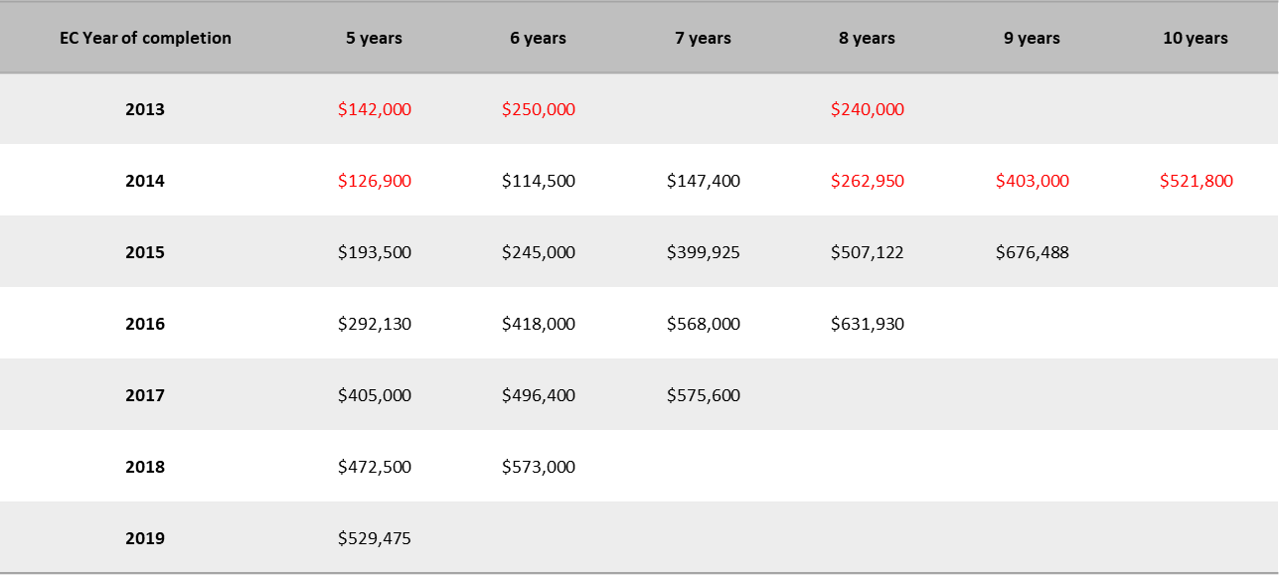
Source: URA, ERA Research and Market Intelligence *Grey cells indicate less than 30 transactions recorded.
Rising Land Cost and EC prices – Does buying an EC still make economic sense?
Amid rising land costs for ECs, driven by both their popularity and limited land sales where only two to three plots are released each year, developers are presented with a unique challenge.
And that is to price their offerings within an affordable range for EC’s buyers whose mortgage loan eligibility are capped by the 30% Mortgage Servicing Ratio (MSR) framework and income ceilings. When combined, both these frameworks will limit buyers’ affordability due to the caps placed on loan quantum, and subsequently, the maximum property value that buyers can finance.
Chart 1: Land Cost vs Median Sale Prices of ECs (by launch year) since 2022
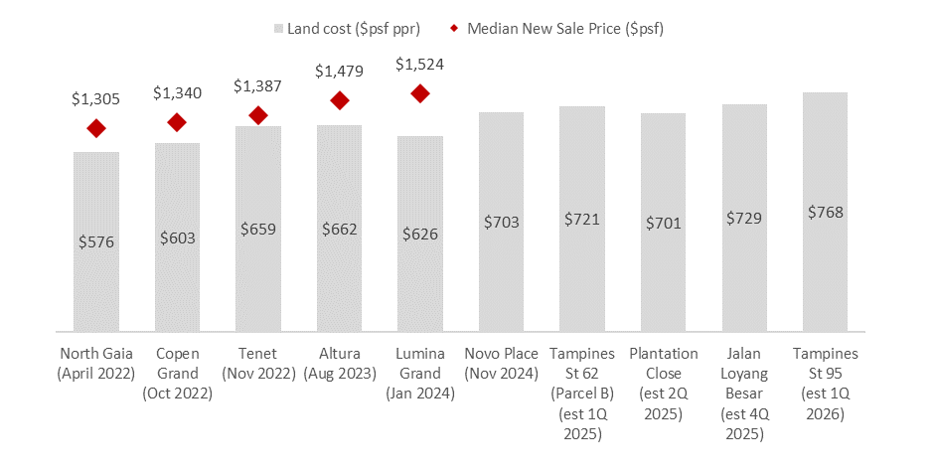
Source: URA REALIS as of 25 Oct 2024, HDB, ERA Research and Market Intelligence
EC Is Still More Attractive Amid Widening Price Gap with OCR New Homes
Even as EC prices continue to climb, the price gap between ECs and new non-landed private homes in the Outside Central Region (OCR) has been steadily widening over the last three years, as the latter record a faster rate of appreciation. In 4Q 2021, the price gap between a new EC and an OCR new home was $388 psf. As of 3Q 2024, this difference has soared to $710 psf.
Chart 2: Median EC and OCR new home prices
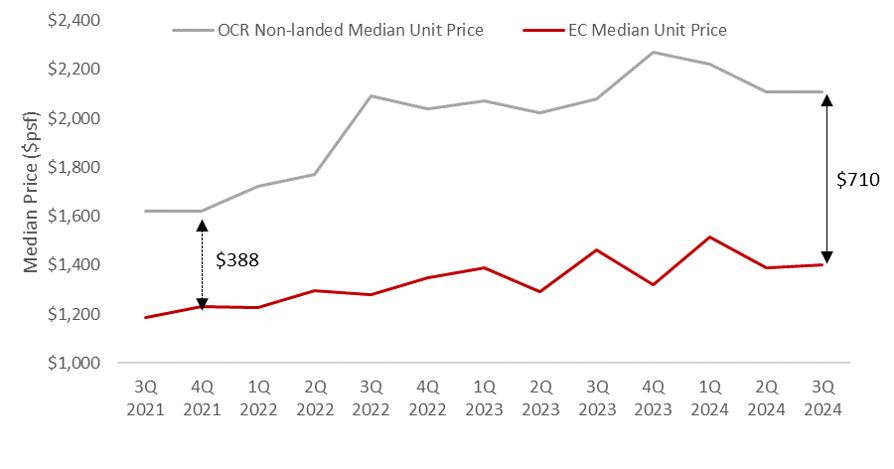
Source: URA, HDB, ERA Research and Market Intelligence
Keeping EC price quantum palatable for first timers
To keep the price quantum within an accessible range, developers have focused on offering more flexible and efficient layouts that allow homebuyers to enjoy the best use of their space. By doing so, this allows developers to keep the price quantum palatable for most buyers.
For instance, first-time buyers, who are typically young couples prefer compact unit layouts that make daily maintenance more manageable, particularly for two working adults. At the same time, they want the flexibility of space to accommodate gatherings at home. For these buyers, the trade-off of a lower price quantum for a smaller unit is often seen as worthwhile.
New ECs Make Upgrading Effortless for Second-Timers
Separately, for HDB upgraders, or second-timers, there are even more compelling reasons to consider a new EC. Firstly, upgraders are exempted from having to pay the Additional Buyer’s Stamp Duty (ABSD), since they will need to dispose of their HDB flat within six months of receiving the keys to their new EC.
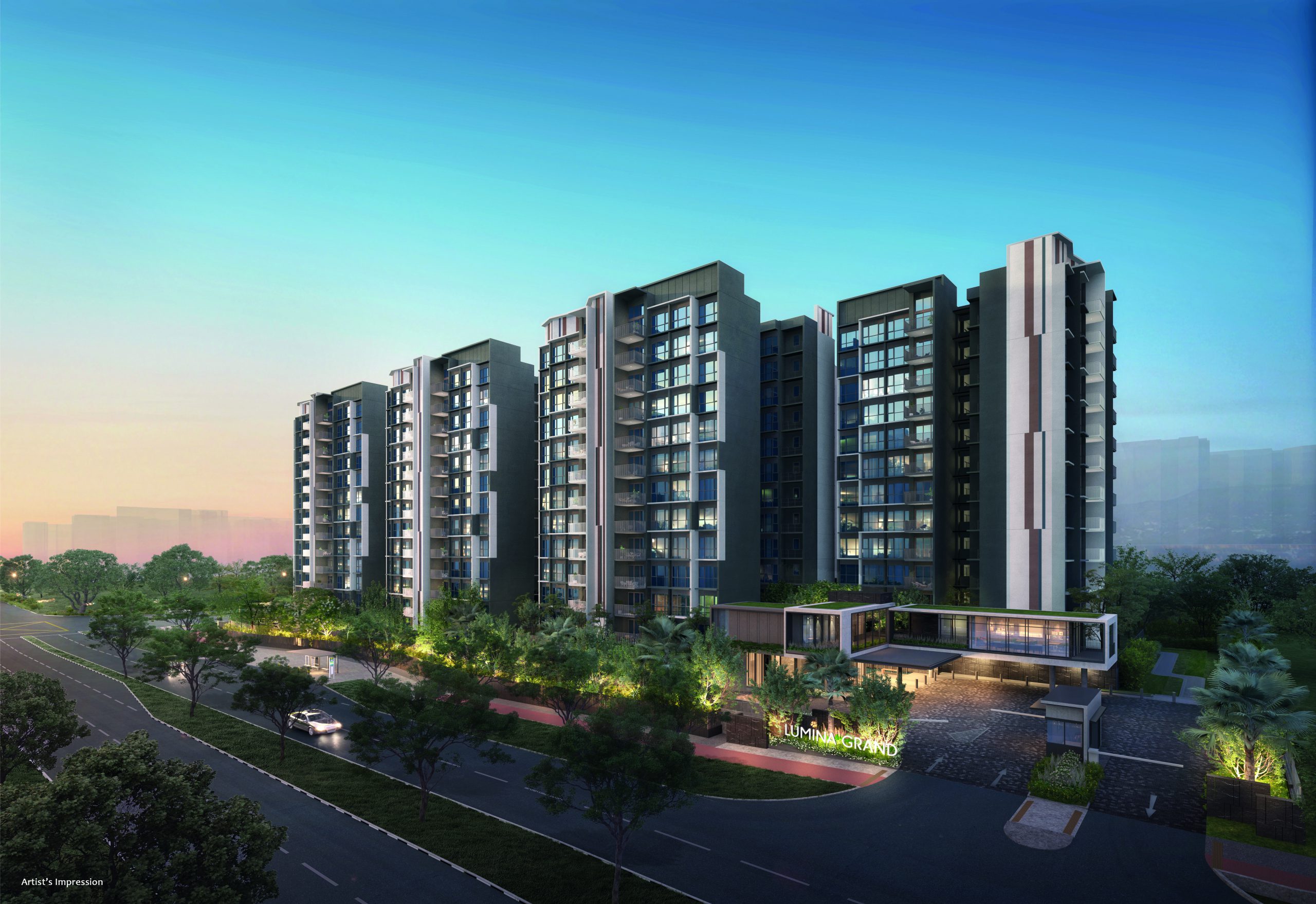
Next, second-timers can also take advantage of the Deferred Payment Scheme (DPS), which, although costing 2-3% more, allows them to defer the balance of 65% until the EC achieves the Temporary Occupation Permit (TOP). The final 15% will then be payable upon the Certification of Statutory Completion. This scheme helps second-timers avoid maintaining two mortgages while waiting for the completion of the new EC.
With the ability to plough their sale proceeds from their HDB flats, second-timers are more likely to be going for the larger 4- or 5-bedroom units.
Developing Townships Provide Valuable Exit Strategies for EC Homeowners
As mentioned, ECs are usually built within developing townships, providing prospective homeowners with a viable exit strategy should they ever plan to relocate after fulfilling the MOP.
To put things into perspective, there have been five ECs launches in the Tengah and Bukit Batok planning areas, with the most recent being Novo Place. These EC projects are located in close proximity to the Jurong Lake District, which is set to transform to the largest business district outside the Central Business District over the next decade. Buyers will stand to gain a first-mover advantage benefit from growth, better connectivity and more amenities in the future.
Additionally, since these ECs are located near the new Tengah estates, there is a large captive pool of HDB upgraders once they complete their MOP.
New ECs offer affordability and deferred payment schemes, which are especially appealing for first-timers and upgraders looking to maximise space and value. However, many of these projects are locate in up and coming estates, which tend to be on the outskirts of Singapore.
So, for homebuyers who place a premium on prime locations and central convenience, resale HDB flats—despite their rising price tags—can often be the more attractive choice. This brings us to the key question: Should you opt for a million-dollar HDB flat instead of new ECs?
New EC or Million-Dollar Resale HDB: Which Is the Better Choice?
To put it simply, location is the answer. The largest advantage of resale HDB flats, and the reason that people are willing to spend upwards of a million dollars on them is due to the ability to purchase an HDB flat in centrally located areas.
Moreover, they are able to purchase larger units in these areas (5-room or executive apartments) for a similar price quantum as the typical entry price for an EC. This is a core reason why we see so many million-dollar flat transactions in city fringe areas.
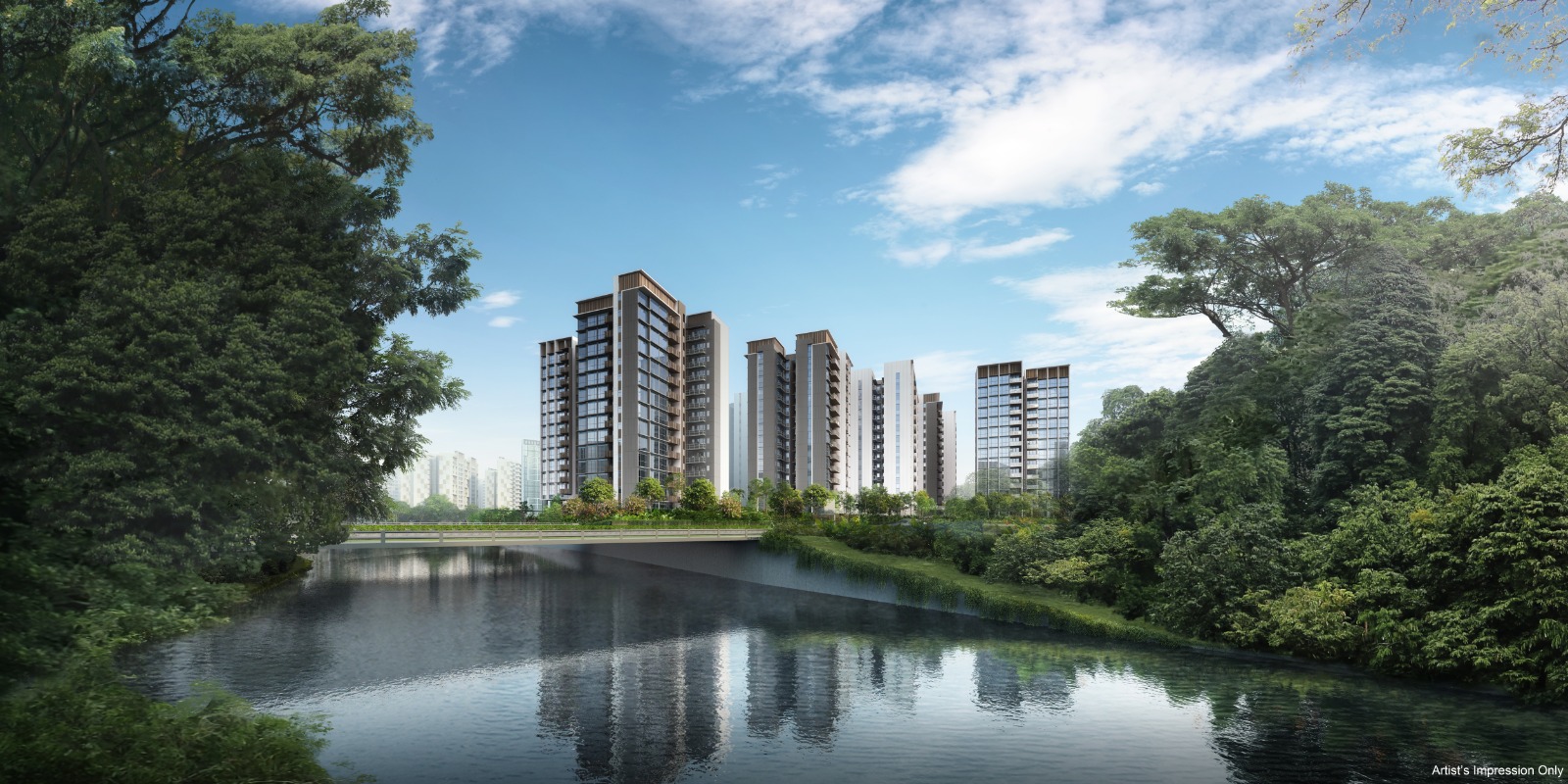
On the other hand, ECs are found in locations further from Central Singapore, typically in up-and-coming housing estates. Despite so, these ECs are often located within walking distance to MRT stations and will benefit as the neighbourhood infrastructure grows and mature.
Another important consideration will be that resale flats come with shorter lease tenures that could limit the loan-to-value limits and loan tenures, whereas new ECs come with a fresh 99-year lease. Buying older flats may also come with other hidden costs from hefty renovation cost to poorly maintain external facades which are difficult and near-impossible to rectify.
So, Is Buying a New EC the Right Move?
To sum it up: ECs are a flexible private property that both the Singaporean first-time buyer and second-time upgrader should strongly consider if they meet the financial requirements.
They feature functional layouts for a variety of family sizes, are growing increasingly more convenient in location, and provide a family with privacy, exclusivity, and access to condominium facilities.
Furthermore, with many ECs situated in up-and-coming housing estates near areas poised for significant transformation, homeowners could benefit from a viable exit strategy should they need to shift in the future to match their families’ changing housing needs. Given their many positives, buying an EC is undoubtedly the right move for any savvy Singaporean property buyer.
Disclaimer
This information is provided solely on a goodwill basis and does not relieve parties of their responsibility to verify the information from the relevant sources and/or seek appropriate advice from relevant professionals such as valuers, financial advisers, bankers and lawyers. For avoidance of doubt, ERA Realty Network and its salesperson accepts no responsibility for the accuracy, reliability and/or completeness of the information provided. Copyright in this publication is owned by ERA and this publication may not be reproduced or transmitted in any form or by any means, in whole or in part, without prior written approval.
Given their on-site facilities, like swimming pools and gyms, as well as the “condominium” label, it’s not hard to see why Executive Condominiums (EC) are an attractive option for homebuyers in Singapore.
Besides offering similar value propositions as regular condominiums, such as the privacy and security of a gated compound, ECs also possess a comparable sense of exclusivity. However, if you were to examine ECs in greater detail, you’ll notice several unique characteristics.
For instance, while new ECs are constructed by private developers, they are subject to similar rules and regulations as public housing (read: HDB flats). This applies to important concerns, including but not limited to, purchase eligibility, Minimum Occupation Period (MOP), and property rental.
So, where exactly do the similarities end and the differences begin for ECs? And more importantly, are they worth buying? For answers, and more, keep scrolling!
What is an Executive Condominium?
In a nutshell, ECs can be viewed as affordable alternatives to conventional non-landed private housing, albeit with key differences in buyer eligibility, as well as selling and renting restrictions.

Eastvale, Singapore’s first-ever Executive Condominium (Source: Google Maps)
For instance, ECs are subject to the same MOP as HDB flats, meaning that owners are prohibited from selling or renting out the entire unit during the holding period, which lasts five years from the date of obtaining the Temporary Occupation Permit.
Upon completion of the five-year MOP, these resale and rental restrictions are loosened, allowing EC owners to sell their home – but only to Singaporeans and Permanent Residents – as well as to rent them out entirely as a unit.
After a further five years from the end of an EC’s MOP, it’ll will achieve full privatisation, making it legally-purchasable by foreigners.
Also, in case you are wondering how ECs came to be as a ‘middle ground’ between HDB flats and private condos, their origins can be traced way back to the nineties.
In 1995, then Prime Minister Goh Chok Tong announced the introduction of a new housing concept to “satisfy the demands of those who aspire to own private property but cannot afford to do so”.
The end result is as we know it – strata-titled residences offering the best of both worlds, in terms of affordability and exclusivity.
How are Executive Condominiums different from private condos?
Besides being subject to the abovementioned regulations by HDB, there are several other notable ways that ECs differ from private condos:

However, if we were to set everything else aside, perhaps the most significant difference (for homebuyers) is the comparatively lower price tag of ECs.
Table 1a: Median psf prices for Executive Condominiums in District 23

Source: URA (as of 26 June 2024), ERA Research and Market Intelligence
Table 1b: Median psf prices for private condominiums in District 23

Source: URA (as of 26 June 2024), ERA Research and Market Intelligence
A quick glance at recent EC and new private condo launches in the same locality lends credibility to this observation.
Units at Altura and Lumina Grand, both ECs, have median prices of $1,479 and $1,525 respectively, whereas homes at their new private condo counterparts in District 23 command median prices of $1,799 and upwards.
Generally, this gap in prices between ECs and private condos can be chalked up to the substantial subsidies provided by the Singapore government, which may amount to as much as $30,000 for eligible first-time EC buyers.
Location, or more specifically, lower land costs associated with quieter sections of Singapore, likely play a contributing role in the greater affordability of ECs as well. And that is because ECs are typically built in up-and-coming areas, away from bustling mature towns where human activity, and also, land prices are higher.
What is the buying journey for a new Executive Condominium like?
Step 1: Find out about your desired EC and eligibility
For buyers in Singapore, the journey of purchasing a brand-new EC begins from the point that a developer announces the launch of a new EC project; this typically takes place 15 months after an EC site has been tendered during a Government Land Sales exercise.
But aside from visiting an EC showroom, buyers will also want to find out if they are eligible to purchase an EC at this stage.
This can be done by checking against the EC applicant eligibility conditions listed on the official HDB website, but generally, these criteria include:

Step 2: Submitting an application to the EC’s developer and waiting for balloting outcome
After completing the initial homework, the next step for buyers would be to apply for a developer’s balloting exercise; this process can be completed online via an e-application or in-person.
At this stage, buyers will also likely be required to provide copies of their identity, income, and marriage documents. So, keep them handy!
Step 3: Unit booking and receiving an Option to Purchase
Following the ballot, successful buyers will be informed and they can schedule an appointment to book their desired unit.
Once done, buyers will then have to pay an Option Fee amounting to 5% of the EC unit’s purchase price – do take note that this amount has to be paid in cash. In exchange, buyers will receive an Option to Purchase (OTP) from the EC’s developer, which is a legal document that grants a buyer the choice to purchase a property within a set option period.
In addition, buyers who wish to utilise their CPF Housing Grant and/or CPF savings will need to apply to the CPF Board at this stage too. Doing so will allow them to use said CPF monies for their downpayment as well.

Lumina Grand, an Executive Condo (EC) in Bukit Batok.
Step 4: Hire a solicitor and finalise housing loan arrangements
By this point, buyers will want to engage a solicitor (a.k.a. a lawyer) to handle the conveyancing process, which will involve lodging a caveat. Doing so ensures that no other interested buyers will be able to purchase their chosen property during the caveat’s validity (i.e., this is the legal equivalent of declaring: “I chope this unit.”).
This is also the stage where buyers should finalise their housing loan arrangements. As ECs cannot be financed using an HDB loan, buyers will have to search for a suitable mortgage package from a bank.
Step 5: Sign the Sales & Purchase Agreement and make stamp duty payments
The Sales & Purchase Agreement is a binding legal contract that documents the intentions and terms of a home purchase, and it will be provided by the EC’s developer when HDB approves a successful application.
Upon receiving a Sales & Purchase Agreement, the next steps for buyers would be to sign it and exercise the OTP. This step will require buyers to pay for the following:
- Booking Fee (5% of the EC’s price)
- Downpayment (15% of the EC’s price)
- Stamp duties (payable where relevant, e.g., Buyer’s Stamp Duty)
Once done, all that is left is waiting for the keys to a brand-new EC home!
How much can you borrow for an Executive Condominium purchase?
If you are taking up a mortgage to pay for an EC purchase, the maximum amount that you can borrow is determined by the Loan-to-Value (LTV) limit.

North Gaia, an Executive Condo (EC) in Yishun.
Presently, the maximum LTV borrowing limit for an EC purchase is 75% for first-timer buyers who do not have an outstanding housing loan. This is also provided that the loan tenure is limited to 25 years, and does not extend beyond the age of 65 for the borrower.
Additionally, EC buyers who are taking up a bank loan are also subject to Mortgage Servicing Ratio (MSR) and the Total Debt Servicing Ratio (TDSR). These thresholds respectively determine how much of a borrower’s gross monthly income can be used to pay off a property loan (MSR of 30%) and all debt obligations (TSDR of 55%).

Source: ERA Research and Market Intelligence
So, for instance, a family with a total household income of $16,000 and no outstanding loans will…
- Have a monthly housing loan eligibility of $16,000 x 30% = $4,800 based on the current MSR limit.
- Be able to allocate up to $16,000 x 55% = $8,800 for all loan repayments based on the current TDSR limit.
- Be able to borrow up to $1,005,000 for an EC on a 30-year bank loan, based on the maximum applicable LTV of 75% and a stress test rate of 4%.
How can you pay for an Executive Condominium?
Broadly, there are two ways that EC buyers can pay for their new home purchase: 1) the Progressive Payment Scheme (PPS) and the 2) Deferred Payment Scheme (DPS).
The PPS, also sometimes referred to as the Normal Payment Scheme, is a progress-based system where instalments are paid only when certain construction milestones are reached. For instance, when an EC attains its Temporary Occupation Period (TOP), a buyer will be required to make a payment amounting to 30% of a property’s value.
As for the DPS, it essentially allows buyers to push back the bulk of their repayments (usually 80% of the property’s value) until their EC achieves its TOP.
Table 2: Difference in payment between PPS and DPS for a $1.5m EC, assuming 75% of the loan is paid

Source: ERA Research and Market Intelligence
While this approach typically results in the total repayment being 2 to 3% higher than the PPS, the DPS could prove valuable for buyers who wish to shore up their cash savings.
The same applies for parties with an existing home loan as the DPS will enable them to service one mortgage at a time, instead of juggling two.
What housing grants are available for Executive Condominiums?
Although EC purchases aren’t eligible for CPF/HDB Housing Loans, it’s still possible for buyers to qualify for the CPF Housing Grant – provided they satisfy the eligibility conditions.
There are two types of CPF Housing Grants available for EC buyers, the Family Grant and Half-Housing Grant.
The Family Grant is applicable to Singapore Citizen (SC) households as well as joint SC and Permanent Resident households, whereas the Half-Housing Grant is applicable for couples consisting of a first-timer (who hasn’t taken any housing subsidies) and a second-timer.
The average gross monthly household income (HHI) stipulated for different tiers of the Family Grant and Half-Housing Grant are summarised as follows:
Table 3a: Family Grant tiers based on average gross monthly HHI

Source: HDB (as of 3 July 2024), ERA Research and Market Intelligence
Table 3b: Half-Housing Grant tiers based on average gross monthly HHI

Source: HDB (as of 3 July 2024), ERA Research and Market Intelligence
So, should you buy an Executive Condominium? What are your options?

Between their attractive price points, comprehensive facilities, and eventual privatisation, ECs have plenty going for them! So, if you are a buyer who is in the market for a new home, these affordably-priced properties should most definitely be on your radar.
At present, there are not one, but three EC developments that buyers can take their pick from. These include:

Source: ERApro (as of 19 July 2024), ERA Research and Market Intelligence
Keen on owning a home at ECs like Altura, Lumina Grand, or North Gaia? Feel free to approach an ERA Trusted Adviser and take your first step towards owning an EC in Singapore!
Disclaimer
This information is provided solely on a goodwill basis and does not relieve parties of their responsibility to verify the information from the relevant sources and/or seek appropriate advice from relevant professionals such as valuers, financial advisers, bankers and lawyers. For avoidance of doubt, ERA Realty Network and its salesperson accepts no responsibility for the accuracy, reliability and/or completeness of the information provided. Copyright in this publication is owned by ERA and this publication may not be reproduced or transmitted in any form or by any means, in whole or in part, without prior written approval.
Picture this: You end a long day of work, and step foot into the mega-development you call home. You are immediately greeted by the familiar sights and sounds of children frolicking about, enjoying their playtime in the estate gardens and the splash pools as the sun sets.
Their parents, who are watching closely, are chatting among themselves. Meanwhile, other residents are seated in an airy alfresco pavilion, catching up with their friendly neighbours over a delicious potluck dinner.
Not everyone may find such a view welcoming – but if you are drawn to the dynamic and vibrant nature of large, urban communities – life in a mega-development may just be the thing for you.

The Treasure@Tampines is an example of a mega-development condo, with over 2,000 units
What is a mega-development condominium?
Mega-developments are condominiums that house 800 or more units. A prime example of a mega-development is the Treasure @ Tampines, home to an astounding 2,203 units.
Mega-developments are generally seen as a fantastic option for owner-occupation properties. The expansive land area permits upscale amenities, while the significant number of units maintains a lower maintenance cost.
There are two current mega-developments available, located in District 15. Furthermore, 2024 will see a further three expected mega-development launches. These include a project in the Rest of Central Region (RCR) and two in the Outside Central Region (OCR). All three developments have 99-year tenures.
Table 1: Current and upcoming Mega-developments launching (2024)

Source: ERA Research and Market Intelligence, ERA Project Marketing
Today, we explore the pros and cons behind living in a mega-development, and who are the buyers that will find value staying in one.
Mega-developments offer more facilities – at a lower maintenance cost
There is an age-old saying: “The bigger, the better.” To a certain extent, this is true for large-scale residential projects in Singapore, particularly mega-developments.
Mega-developments occupy large sites, allowing for more common facilities. To illustrate, the Treasure @ Tampines houses 128 facilities, including an aqua aerobic pool and a trampoline courtyard. By contrast, the Alps Residences, another project within the same district (D18), has only 31 facilities.
Even though residents of mega-developments get to enjoy a wider selection of facilities, the maintenance fees payable tend to be on the lower end, as they benefit from economies of scale, with more residents contributing to maintenance fees.
We conducted a study comparing the maintenance fees payable for three notable mega-developments to another three mid-sized developments within the same districts. Firstly, the three mega-developments offer up to an impressive 128 facilities. Secondly, residents of mega-developments could pay between 7% – 26% lower maintenance fees than mid-sized developments.
Table 2: Comparison of maintenance fee and number of facilities
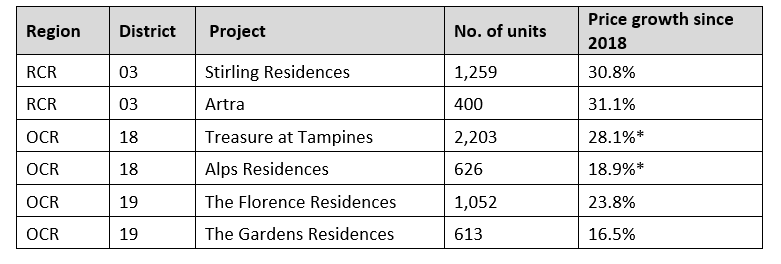
Source: ERA Research and Market Intelligence
Mega-developments offer a vibrant and dynamic environment
Life in a mega-development is always vibrant and lively – there is never a dull moment as there is always something going on in the estate!
Mega-development condominiums offer a wide range of amenities. From common amenities such as swimming pools and exercise areas to unique offerings like jamming studios and virtual golf rooms, mega-developments have something for everyone.
This creates opportunities for interaction among community members. Young children will have no shortage of peers to socialise with at the many playgrounds and child play areas. Adults can enjoy the many fitness facilities and communal areas for work-from-home arrangements. Seniors in particular benefit from the vibrant community and activities to keep themselves active and occupied. This makes mega-developments a fantastic choice for multi-generational families.

Mega-developments feature a vibrant community, especially for young children
Mega-developments are a fantastic property choice for people who enjoy hosting. From barbecue pits to tennis courts, the countless facilities found in a mega-development are sure to make guests of all ages feel welcome and entertained.
There are also regular events and activities organized by the management corporation of these large developments. Fancy joining a Easter egg hunts or a Mid-Autumn Festival walk around the development and bonding with your neighbours at the same time? One can expect higher participation rate than in a regular condominium. This will provide management with more resources to plan these events, resulting in more frequent and larger scale events that provide fun and enrichment for residents.
Mega-developments make a worthwhile investment property
Mega-developments typically see a high number of transactions. This is due to the sheer number of units of various sizes and configurations available.
Given the size of these mega-developments, the likelihood of a transaction happening in the development is higher, as there are more units available. With higher sales frequency, we can expect healthier price growth.
Comparing our three earlier examples of mega-developments and smaller developments in the same district, we can conclude that mega-developments generally see better price growth.
Table 3: Comparison of Price Performance
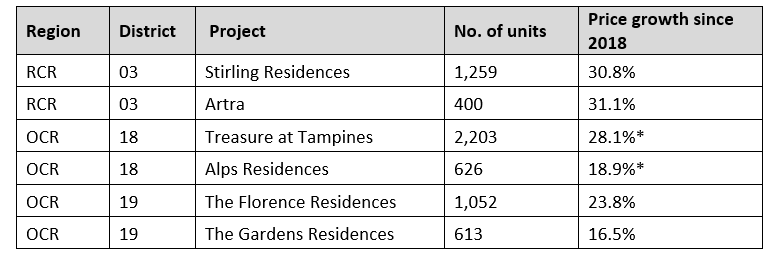
Source: URA as of 17 May 2024, ERA Research and Market Intelligence *From 2019, when Treasure at Tampines was launched
A deeper dive comparing the two District 19 projects, The Gardens Residences and The Florence Residences (mega-development) further illustrates this. We can observe how the sheer number of units and transactions a mega-development can contribute to a healthy price growth.
Chart 1: Example of Mega-developments vs a smaller development in District 19
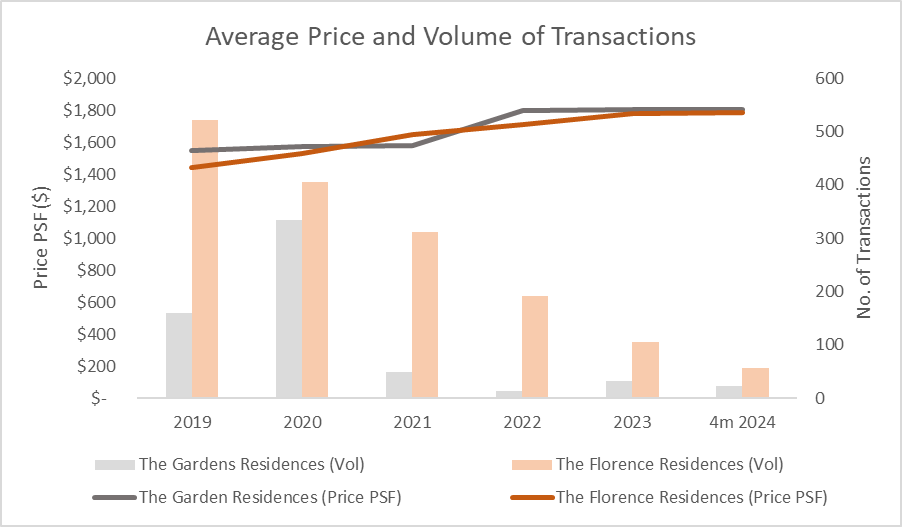
Source: URA as of 17 May 2024, ERA Research and Market Intelligence
While mega-developments offer many upsides, there are a few cons that might make them unsuitable for some property buyers.
Privacy-conscious homebuyers may find mega-developments unsuitable
The first and most obvious drawback is the lack of exclusivity. Mega-developments may not be for you if you prefer a more private and quieter environment, as there is an almost perpetual state of activity going on, with people walking around, children playing, and noise being made.
There is also a higher likelihood of units being bought and sold within mega-developments. This leads to people constantly shifting in and out, and regular renovations, which might feel disruptive for residents.

The high level of activity in mega-developments could be disruptive to those who prefer a quieter, more privacy-conscious lifestyle
Buyers that idealise a private and quiet atmosphere would find something like a boutique development, which has less than 100 units more desirable to live in, as compared to the sprawling size of a mega-development.
Facilities might end up under-utilised or under-maintained
While mega-developments pride themselves on the large number of facilities they have to offer, they are not always in use by residents. This is especially true for less-used facilities (such as virtual golf rooms, or jamming studios), which often find themselves under-utilised and under maintained.
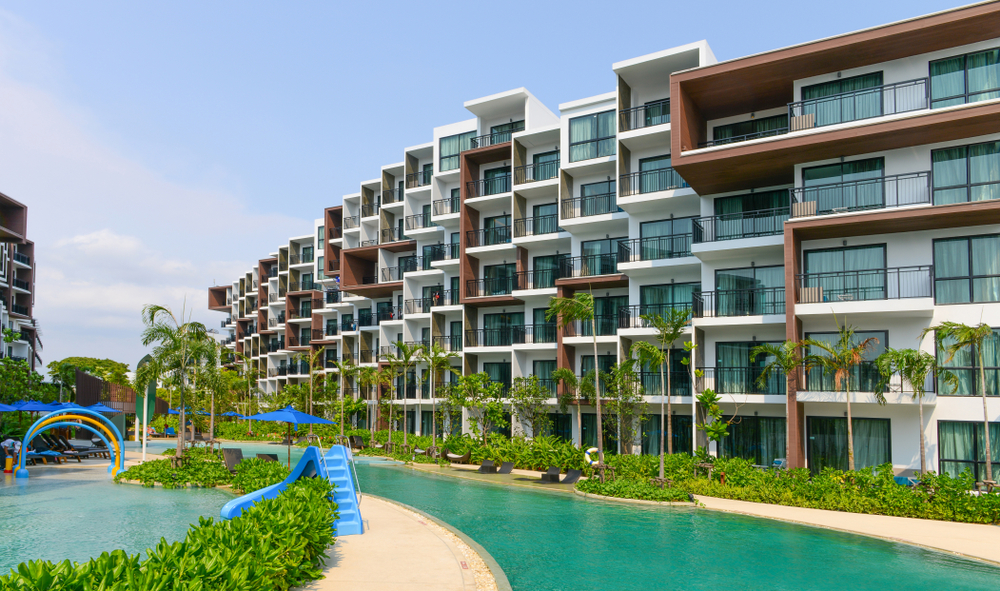
Due to the large number of residents using the facilities in mega-development condos, they require more frequent upkeep.
Popular facilities such as swimming pools or children’s playgrounds that see regular usage are also likely to degrade faster, requiring more frequent upkeep.
Due to the large size of these projects, it is not uncommon to see run-down areas, a side-effect of the struggle to keep such a large estate in good condition. This is especially true the older these developments get.
Mega developments are crowded and sometimes inconvenient
The larger number of people that stay in mega-developments results in more competition to use popular facilities. Tennis courts and function rooms often have to be booked in advance through an online process with limited slots. Free-use facilities such as lap pools and gyms are often be packed, especially during peak hours.
Residents might have to find themselves visiting these facilities at weird timings just to avoid the crowd, which takes away the convenience factor of having in-house facilities.

The large number of residents often results in long wait times for the lift
This aforementioned waiting time caused by crowds also spills into other common areas, notably lifts and parking areas. Lifts in mega developments are often slow, due to the sheer number of people that use them. Bear in mind that with more residents comes more food delivery riders, couriers, and movers, who all share the use of the same lifts.
Those who drive to work also feel the brunt of the crowd when leaving the compound in the morning. With a large number of people trying to leave the condo through the same egress points, residents are bound to run into ‘traffic congestion’ even before exiting the premises.
Is a Mega-Development Right for Me?
Based off these aforementioned factors, we can conclude that mega-developments are fantastic, value-for-money properties, both for owner-occupancy and as an investment property.
They make an excellent choice for families with children, as they have the most to benefit from the diverse range of facilities available right at their doorstep. Fancy the idea of an entire day of entertainment – without the need to leave the front gate!
The lively atmosphere inside these mega-developments also make them a fantastic option for older folks who are downgrading. Chock full of activities and amenities, they provide seniors with the activity level, friends and community needed to keep them engaged and to prevent them from feeling lonely.

Mega-development homes are fantastic choice for multi-generational families
These facilities have proven to evolve along with the needs of its many residents. A fantastic example of this are newer developments creating communal spaces that are conducive towards and can function as co-working spaces for people with remote working arrangements – a trend that is common these days.
Facility bookings are often done via smartphone apps nowadays, which adds to the ease of access and convenience that residents of these mega-developments can enjoy.
Offering a fantastic value proposition alongside a multitude of lifestyle factors built into the property itself, it is no wonder why mega-developments are on the rise, and why you should strongly consider one as your next property purchase.
To find out more about the upcoming mega-development launches, speak to an ERA Trusted Adviser today.
Disclaimer
This information is provided solely on a goodwill basis and does not relieve parties of their responsibility to verify the information from the relevant sources and/or seek appropriate advice from relevant professionals such as valuers, financial advisers, bankers and lawyers. For avoidance of doubt, ERA Realty Network and its salesperson accepts no responsibility for the accuracy, reliability and/or completeness of the information provided. Copyright in this publication is owned by ERA and this publication may not be reproduced or transmitted in any form or by any means, in whole or in part, without prior written approval.